


This site is made possible by member support. 💞
Big thanks to Arcustech for hosting the site and offering amazing tech support.
When you buy through links on kottke.org, I may earn an affiliate commission. Thanks for supporting the site!
kottke.org. home of fine hypertext products since 1998.
Entries for April 2017
Some things I’ve read, seen, and heard in the past few weeks
1984. I believe I last saw this movie in high school, which seems unlikely given the nudity. Or maybe we saw a censored version, in which case: lolololol. (B+)
Ghost in the Shell. Superb visuals but the story felt flat. (B)
Big Little Lies. I almost gave up on this after two episodes. I can watch TV characters do all sorts of horrible things to each other — lie, cheat, steal, betray, kill — but apparently epically bad parenting is my last straw. But. The final episode contains one of the best scenes I’ve ever watched on TV and was just fantastic all around. Was literally on the edge of my seat for the entire 60 minutes. (A-)
Future Sex. Among the least titillating books about sex you’ll ever read. (That’s a compliment.) (B+)
The Undoing Project. I was unsure about this one until about 1/3 through but persisted because it’s Michael Lewis. Fascinating in places and unexpectedly emotional. (B)
Mr. Bean. I have never seen my kids laugh quite as hard as they did watching Mr. Bean rush to the dentist office. My dad instilled in me an appreciation of British comedy and I guess I’m passing that on to my kids. They seem to get it, but not all kids do. They were so excited recently to show some friends The Ministry of Silly Walks sketch from Monty Python and the friends looked really really confused and didn’t laugh at all. Fawlty Towers is up soon. (B)
The Rules Do Not Apply. At one shocking, heartbreaking point in the book, time reels backwards. If you’ve read Ariel Levy’s Thanksgiving in Mongolia in the New Yorker, you know exactly what I’m talking about. (B+)
Tim Carmody’s Best of the Web series for kottke.org. I love getting to be a reader of the site sometimes, just like all of you. I always enjoy Tim’s residencies here, but this one made me clap my hands in joy and stomp my feet in a jealous rage. It’s not entirely fair that he does the site better than I do, but I’m glad he does. (A)
The final season of Girls. Not their best season, but I’m sad to see it go nonetheless. The ensemble is what made the show special, and they just weren’t together enough this season. The single episode “goodbyes” for each character felt forced. (Same reason why Arrested Development season 4 wasn’t up to scratch.) (B+)
Terror of the Zygons. I started watching old Doctor Whos with the kids and they love them. (B-)
Hedgehog Launch. Ancient iOS game…my phone might contain the last functioning install of it. I started playing it a few weeks ago and now I am addicted to it for absolutely no good reason. The game sucks: it’s tough and not that fun until a certain point and then it gets really easy to win. But I can’t stop playing it. It’s like a metaphor for something in my life I can’t quite figure out. Fuck this game. (F)
Damn. I need to listen to this more. So I shall. (B+)
Get Out. Really good but not great. I saw this weeks after everyone else and my expectations were too high. Kept waiting for it to slip into a slightly higher gear but it never did. Don’t @ me! (B+)
Cloud Atlas. I’ve seen this movie at least four times and I love it. (A-)
The Prestige. Hadn’t seen this since it came out. Holds up. Had totally forgotten about Bowie as Tesla. (A-)
The Holy Mountain. Was way too sober for this. (B-)
The Life Aquatic. Not my favorite Wes Anderson but solid. There’s some weirdly clunky acting in the middle bits. (B+)
Guardians of the Galaxy. Gearing up for the new one. (A-/B+)
See also the last installment of this list from earlier this month.
The Meeting That Never Happened
IDAC is an entertaining short film by Casimir Nozkowski that explores the social mores of the awkward youth and, after a twist in the story, the malleability of memory.
When I was leaving for college, my aunt Dana told me I had a cousin I’d never met who was matriculating in the same year as me. We shared classes and had friends in common but for some strange reason I never introduced myself. All during college, and then into the real world, through a decade of overlapping connections, we never met. This film is an examination of that hesitation and an attempt to understand why I never made the easiest connection in the world… until it was too late.
What is literature for?
The School of Life on four uses of literature. I especially liked this bit:
We’re weirder than we’re allowed to admit. We often can’t say what’s really on our minds, but in books, we find descriptions of who we genuinely are and what events are actually like described with an honesty quite different from what ordinary conversation allows for. In the best books, it’s as if the writer knows us better than we know ourselves. They find the words to describe the fragile and weird special experiences of our inner lives: the light on a summer morning, the anxiety we felt at a gathering, the sensations of a first kiss, the envy when a friend told us of their new business, the longing we experienced on the train looking at the profile of another passenger we never dare to speak to. Writers open our hearts and minds and give us maps to our own selves, so that we can travel in them more reliably and with less of a feeling of paranoia and persecution. As the writer Emerson remarked, “In the works of great writers, we find our own neglected thoughts.”
I would argue these points also apply, in one degree or another, to not just literature but to any artful endeavor: film, TV, comics, theater, painting, etc.
Field Guide to Dumb Birds of North America. “I hate birds. These are my field notes.”
Dieter Rams’ classic design principles updated for the tech industry
Dieter Rams, the legendary designer, came up with a now-famous list of Ten Principles for Good Design. Among them:
Good design makes a product understandable. It clarifies the product’s structure. Better still, it can make the product talk. At best, it is self-explanatory.
Recently, designer Tobias Van Schneider posted a tongue-in-cheek update of Rams’ list, the 2017 Tech Industry edition.

1. Good design is disruptive.
2. Good design makes a product addicting.
3. Good design is A/B testing.
4. Good design makes a product collect data.
5. Good design is notifications.
6. Good design is agreeing to the terms & conditions.
7. Good design is temporary.
8. Good design is a prototype.
9. Good design is a chatbot?
10. Good design is pleasing your shareholders.
Night Time Lapse of the Milky Way from an Airplane Cockpit
Sales Wick is a pilot for SWISS and while working an overnight flight from Zurich to Sao Paulo, he filmed the first segment of the flight from basically the dashboard of the plane and made a timelapse video out of it. At that altitude, without a lot of light and atmospheric interference, the Milky Way is super vivid.
Just as the bright city lights are vanishing behind us, the Milky Way starts to become clearly visible up ahead. Its now us, pacing at almost the speed of sound along the invisible highway and the pitch-black night sky above this surreal landscape. Ahead of us are another eight hours flight time, but we already stopped counting the shooting stars. And we got already to a few hundred.
I watched this twice already, once to specifically pay attention to all the passing airplanes. The sky is surprisingly busy, even at that hour. (via @ozans)
Update: Several people asked if this was fake or digitally composited (the Milky Way and ground footage shot separately then edited together). I don’t know for sure, but I doubt it. The answer lies in the camera Wick used to shoot this, the Sony a7S. It’s really good in low-light conditions, better than many more expensive professional cameras even. As the last bit of this Vox video explains, the camera is so good in low light that the BBC used it to capture some night scenes for Planet Earth II. Here’s a screen-capped comparison at 6400 ISO from that video:
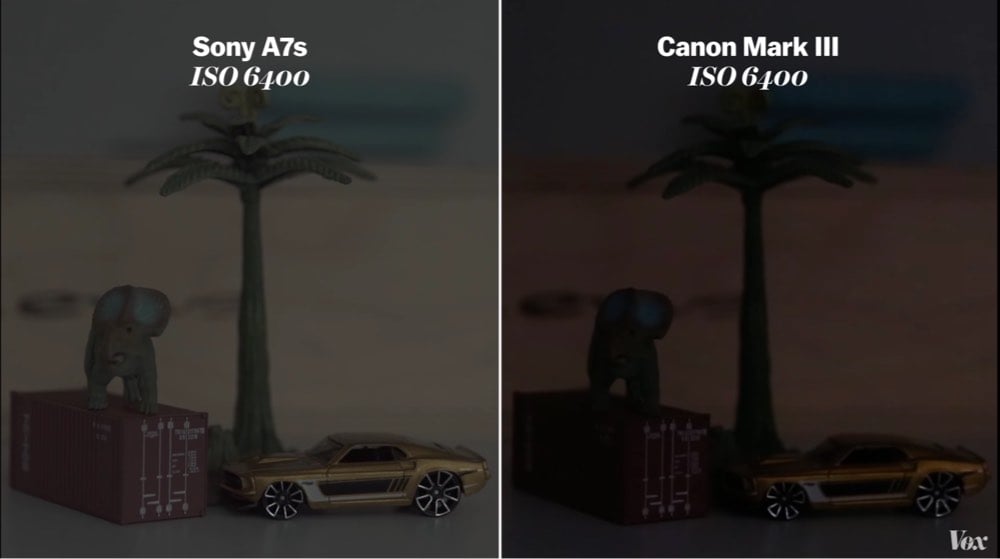
And the full scene at 32000 ISO:
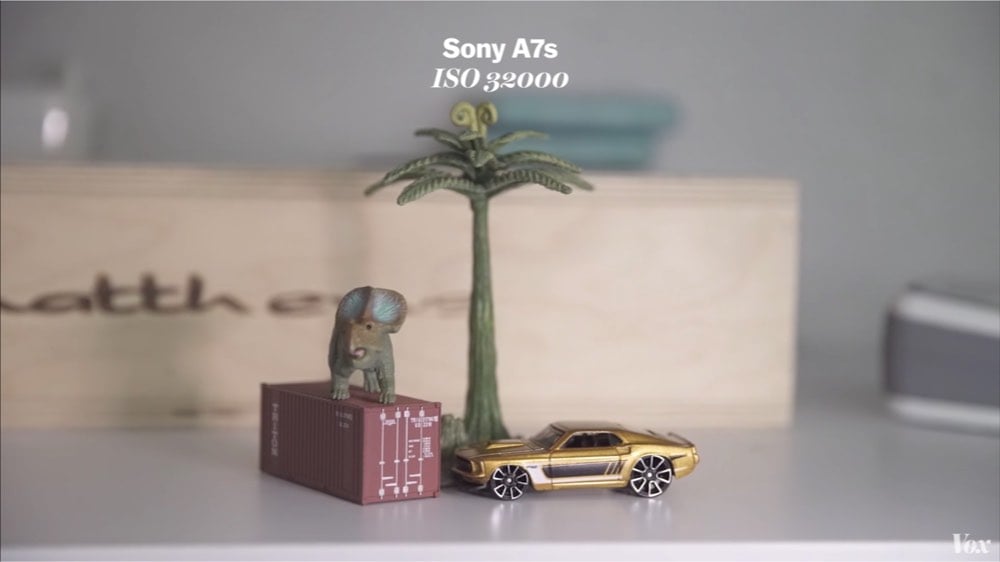
That’s pretty amazing, right? Wick himself says on his site:
I had to take many attempts and a lot of trying to figure it out. Basically the challenge is to keep shutter speed as fast as possible in order to get razor sharp images. While you can use the 500 or 600 rule on ground this doesn’t work out the same way while being up in the sky. Well of course basically it does if you dont fly perpendicular to the movement of the night sky but even if its really smooth there are usually some light movements of the aircraft. So depending on the focal length of your lense you can get exposure times between 15” to 1”. Thats why you will need a camera that can handle high iso. Thats where the A7s comes into play and of course a ver fast lense. The rest is a good mounting and some luck. Last but not least you need to keep the flight deck as dark as possible to get the least reflections…and the rest is magic ;)
The absurd precision involved in detecting gravitational waves
Back in September 2015, the LIGO experiment detected gravitational waves formed 1.3 billion years ago when two black holes merged into one. The physics is pretty straightforward but to get the measurement, scientists had to build one of the most sensitive machines ever built. How sensitive? To get an accurate result, they needed to measure a distance of 4km with an accuracy of 1/10000th the width of a proton. This video from Veritasium looks at how the scientists and engineers accomplished such an amazing feat.
Road Dieting
The concept of road diets is an alternate approach to dealing with road congestion that’s gained popularity in recent years. The typical solution to heavy traffic on roads is to widen them with more travel lanes. The problem is such an approach can induce demand and instead of two lanes of traffic jam, you get four lanes going nowhere.1
Instead, with a road diet approach, you might turn a four-lane road into three lanes: two travel lanes and a turn lane in the middle.
Realizing these unintended outcomes, some localities implemented a type of road diet: reconfiguring the four lanes (two in each direction) into three (one each way plus a shared turn lane in the middle). The change dramatically reduced the number of “conflict points” on the road-places where a crash might occur. Whereas there might be six mid-block conflict points in a common four-lane arterial, between cars turning and merging, there were only two after the road diet.
Likewise, at an intersection, eight potential conflict points became four after a road diet.
The result was a much safer road. In small urban areas (say, populations around 17,000, with traffic volumes up to 12,000 cars a day), post-road diet crashes dropped about 47 percent. In larger metros (with populations around 269,000 and up to 24,000 daily cars), the crash reduction was roughly 19 percent. The combined estimate from all the best studies predicted that accidents would decline 29 percent, on average, after a four-to-three-lane road diet — DOT’s reported figure.
Pedestrian and bike usage tends to increase as well (b/c that extra street can be converted to bike lanes or sidewalks), speeding decreases, and car travel times are largely unaffected. This quick video by Jeff Speck shows four different approaches to road dieting:
Update: See also Braess’ paradox.
Braess’ paradox or Braess’s paradox is a proposed explanation for a seeming improvement to a road network being able to impede traffic through it. It was discovered in 1968 by mathematician Dietrich Braess, who noticed that adding a road to a congested road traffic network could increase overall journey time, and it has been used to explain instances of improved traffic flow when existing major roads are closed.
The paradox may have analogues in electrical power grids and biological systems. It has been suggested that in theory, the improvement of a malfunctioning network could be accomplished by removing certain parts of it.
(thx, david)
Update: A street in Oakland recently underwent a road diet: two of five lanes were converted into protected bike lanes. The result is an increase in biking and pedestrian use, a decrease in collisions, a decrease in speeding, and an increase in business along the street.
Along nine blocks of Oakland’s Telegraph Avenue, biking is up 78 percent since protected bike lanes were installed. Walking is up 100 percent - maybe because, thanks to the single lane of through traffic in each direction, the pedestrian yield rate doubled in the mornings and tripled in the afternoons.
Meanwhile, the number of traffic collisions fell 40 percent. Retail sales in a district that has sometimes struggled are up 9 percent, thanks in part to five new businesses.
And the median car speed is now the speed limit: 25 mph. As usual on such projects in urban areas, the main effect of removing a car passing lane was not to jam traffic, only to prevent irresponsible drivers from weaving between lanes in order to get to the next stoplight more quickly.
The concept of induced demand can be seen in other places, like New Orleans’ overcrowded jails. ↩
How Fake Are Nature Documentaries?
When you’re watching a nature documentary, you notice it right away: there’s something odd about the sound effects. They seem a little too…Hollywood. When Vox did their series on how the BBC made Planet Earth II, they didn’t mention the sound:
I hope the third program is on sound, which has been bugging me while watching Planet Earth II. I could be wrong, but they seem to be using extensive foley effects for the sounds the animals make — not their cries necessarily, but the sounds they make as they move. Once you notice, it feels deceptive.
Several other people noticed and complained, causing the BBC to explain that getting real sounds in many cases was impossible. Audio producer Matt North adds some context:
Whilst I’m no wildlife expert, it’s fairly straightforward to conclude that such an unpredictable and uncontrollable subject as wildlife would have prompted the need to often shoot on long lenses, thus making it almost physically impossible for a sound recordist to obtain ‘realistic’ recordings that would match the treatment and emotive style of the programme. Combine this with the shooting climate, as well as the need for frequent communication between crew just to capture the necessary shots that will cut well in the edit suite and you have a recipe for failure in regards to obtaining useable sound. Therefore, it’s not only impractical but virtually impossible to capture the ‘real’ sound that some of these disgruntled viewers may be protesting for.
As Simon Cade shows in the video above, sound is only one of the ways in which nature documentaries use editing to “fake” things. Is it manipulation? Or good storytelling? And what’s the difference between the two anyway? A silent security feed of a Walmart parking lot is not a documentary but The Thin Blue Line, with its many dramatizations and Philip Glass score, is a great documentary.
Update: 99% Invisible recently did a show on the sounds in nature documentaries as well. (thx, everyone)
A brief visual history of Studio Ghibli
Studio Ghibli has been making incredible animated movies since 1985. This video traces the history and the work of the studio and its principal director Hayao Miyazaki from his pre-Ghibli work (including Nausicaä of the Valley of the Wind) all the way up to Miyazaki’s recent unretirement & involvement in Boro the Caterpillar.
The name Ghibli was given by Hayao Miyazaki from the Italian noun “ghibli”, based on the Libyan-Arabic name for the hot desert wind of that country, the idea being the studio would “blow a new wind through the anime industry”. It also refers to an Italian aircraft, the Caproni Ca.309 Ghibli.
I still remember seeing Princess Mononoke in the theater in 1999 (having no previous knowledge of Ghibli or Miyazaki) and being completely blown away by it. Made me a fan for life. (via film school rejects)
Update: The Movies of Studio Ghibli, Ranked from Worst to Best. Happy to see Princess Mononoke in the top spot and surprised at Spirited Away’s relatively low placement.
Did humans arrive in America 115,000 years earlier than commonly accepted? (Spoiler: probably not.)
Seinfeld-sourced paper gets into “legit” science journal
John McCool suspected that a scientific journal called the Urology & Nephrology Open Access Journal was essentially a pay-to-publish journal with a flimsy peer-review process. So he wrote a paper based on a bogus medical condition made up for an episode of Seinfeld and submitted it to them.
This was inspired by the classic 1991 episode “The Parking Garage,” where the gang can’t find their car in a mall parking garage. Eventually, Jerry has to urinate; he goes against a garage wall and gets busted by a security guard; and he tries to get out of it by claiming that he suffers from a disease called “uromycitisis” and could die if he doesn’t relieve himself whenever and wherever he needs to.
I went all out. I wrote it as Dr. Martin van Nostrand, Kramer’s physician alter ego, and coauthored by Jay Reimenschneider (Kramer’s friend who eats horse meat) and Leonard “Len” Nicodemo (another of Kramer’s friends, who once had gout). I included fake references to articles written by the likes of Costanza GL, Pennypacker HE, and Peterman J. I created a fake institution where the authors worked: the Arthur Vandelay Urological Research Institute. In the Acknowledgements section, I thanked people such as Tor Eckman, the bizarre holistic healer from “The Heart Attack” episode, giving him a “Doctor of Holistic Medicine (HMD)” degree.
The Arthur Vandelay Urological Research Institute!! That’s some top-shelf trolling right there. If you read the full paper, you’ll also see references to Steinbrenner and Lloyd Braun. Of course the journal accepted and published it:
The journal was excited to receive this “quality” and “very interesting” case report. A mere 33 minutes after receiving it, a representative notified “Dr. van Nostrand” that it had been sent out for peer review (a process the journal’s website touts as “rigorous”). Three days later, reviewer comments were returned to me, and I was asked to make a few minor changes, including adding lab test results from when the patient was in the emergency room. I made these up, too, and promptly resubmitted the revised case report. Soon after, it was officially accepted for publication.
The publication eventually figured out it had been pranked and had a quick back-and-forth with McCool about it.
Endless robotic loop of a toy train
This video of robot continuously building a looped track in front of a toy train is definitely a metaphor for something. Procrastination? Living paycheck to paycheck? Life with small children? I don’t know, but it makes me SO ANXIOUS! Why does it wait so long to place the next section of track?!! I couldn’t watch for more than 10 seconds or so.
See also the chase scene from The Wrong Trousers. (via @MachinePix)
Bowler rolls a perfect 300 game in just 90 seconds
My top bowling score is probably 1381 and took more than an hour because there were 6 people using the same lane and no one was really paying that much attention to anything other than conversation and chicken wings. This guy, using all the lanes in the alley, rolled a 300 in just under 90 seconds. With two hands…I’ve never seen that before. And I love the way he scampers from lane to lane.
Or somewhere in the high 200s if you count Wii bowling. I don’t think I ever scored a perfect 300 on the Wii.↩
Preemie lambs successfully grown to term in artificial wombs

Researchers at The Children’s Hospital of Philadelphia have succeeded in gestating premature lambs in artificial wombs. The abstract from the paper in Nature Communications:
In the developed world, extreme prematurity is the leading cause of neonatal mortality and morbidity due to a combination of organ immaturity and iatrogenic injury. Until now, efforts to extend gestation using extracorporeal systems have achieved limited success. Here we report the development of a system that incorporates a pumpless oxygenator circuit connected to the fetus of a lamb via an umbilical cord interface that is maintained within a closed ‘amniotic fluid’ circuit that closely reproduces the environment of the womb. We show that fetal lambs that are developmentally equivalent to the extreme premature human infant can be physiologically supported in this extra-uterine device for up to 4 weeks. Lambs on support maintain stable haemodynamics, have normal blood gas and oxygenation parameters and maintain patency of the fetal circulation. With appropriate nutritional support, lambs on the system demonstrate normal somatic growth, lung maturation and brain growth and myelination.
The Atlantic’s Olga Khazan translates what that might mean for human babies born prematurely.
One reason preterm birth is so dangerous is that, for an underweight baby, the first few breaths of air halt the development of the lungs. “Infants that are currently born and supported in a neonatal intensive care unit with gas-based ventilation demonstrate an arrest of lung development,” Partridge says, “which manifests in a long-term, severe restriction of lung function.”
With the artificial womb, the infant would continue “breathing” through the umbilical cord as its floats in amniotic fluid, which would flow into and out of the bag. Using its tiny heart, the fetus would pump its own blood through its umbilical cord and into an oxygenator, where the blood would pick up oxygen and return it to the fetus-much like with a normal placenta. In addition to boosting lung growth, the amniotic fluid would protect the baby from infections and support the development of the intestines.
If this does work for humans, there’s a possibility that at some point using artificial wombs may be safer (or just preferable for some people) than women carrying babies to term…which would have an interesting effect on childbirth (to say the least). And as Khazan mentions, there are potential implications related to abortion rights:
If they ever materialize, artificial wombs may stir concerns among pro-choice advocates, since the devices could push the point of viability for human fetuses even lower. That might encourage even more states to curtail abortions after, say, 20 weeks’ gestation. But speaking with reporters Monday, the Philadelphia researchers emphasized they don’t intend to expand the bounds of life before the 23rd gestational week. Before that point, fetuses are too fragile even for the artificial wombs.
Update: There’s a short video clip of the lamb in the artificial womb as well:
The writers strike and the rise of Trump
The members of the two large writing guilds representing more than 12,000 Hollywood writers recently voted to strike.
Leaders of the Writers Guild of America, East, and the Writers Guild of America, West, announced the results of an online strike authorization vote in an email to members. The unions said that 6,310 eligible members voted; 96 percent of the vote was in favor of a strike.
A three-year contract between the guilds and the Alliance of Motion Picture and Television Producers, which represents the makers of films and TV series, expires at midnight on May 1. Negotiators were set to resume talks on Tuesday, with funding of a failing union health care plan a sticking point.
Last time there was a writers strike in 2007, networks moved to replace their scripted shows with reality programs, including the resurrection of a fading reality show called The Apprentice.
During the last work stoppage, CBS ordered additional seasons of its flagship reality competition shows to fill airtime. And then there’s NBC.
Trump’s “The Apprentice” had been removed from the network’s lineup amid low ratings. But a new programming chief came aboard in 2007, and the network decided to revive the competition show, but with a twist. And when the writers’ strike meant no more new episodes of “The Office” and “Scrubs,” NBC replaced the Thursday night shows in 2008 with “The Celebrity Apprentice.”
That’s a curious butterfly effect. The writers strike made room for The Celebrity Apprentice on TV. The Celebrity Apprentice gave Trump seven more seasons of primetime TV visibility. Trump parlayed that visibility into the highest political office in the land.
Option B: building resilience and finding meaning in the face of adversity
Two years ago, Facebook COO and Lean In author Sheryl Sandberg lost her husband to an unexpected death. The loss left her bereft and adrift. Grieving hard, she struggled to figure out how to move forward with her life. The result of her journey is a book co-authored by Adam Grant called Option B: Facing Adversity, Building Resilience and Finding Joy.
After the sudden death of her husband, Sheryl Sandberg felt certain that she and her children would never feel pure joy again. “I was in ‘the void,’” she writes, “a vast emptiness that fills your heart and lungs and restricts your ability to think or even breathe.” Her friend Adam Grant, a psychologist at Wharton, told her there are concrete steps people can take to recover and rebound from life-shattering experiences. We are not born with a fixed amount of resilience. It is a muscle that everyone can build.
Option B combines Sheryl’s personal insights with Adam’s eye-opening research on finding strength in the face of adversity.
Jessi Hempel’s piece on Sandberg is a good overview on the book and that period in her life, particularly in relation to Sandberg’s return to work and how that changed leadership & communication at Facebook.
Every year in late May, Facebook gathers its policy and communications team for a day-long retreat. Employees fly in from satellite offices in Germany, say, or Japan. It’s a chance to address problems, and set strategy for the year to come.
Sandberg always speaks, but that year Caryn Marooney, who was then in charge of technology communications, remembers everyone told her she could skip it. She insisted on coming anyway. As 200 people looked on, she began telling the group what she was going through, and how it was. “There were a lot of tears. It was incredibly raw, and then she said, “I’m going to open it up to Q and A,” Marooney remembers. People spoke up.
Talking about her situation allowed Sandberg — and the entire team — to move past it and transition into a productive conversation. Having acknowledged the proverbial elephant in the room, they could all focus on the work at hand. “I think people think that vulnerable is soft, but it’s not,” said Marooney, as she described Sandberg’s tough approach to business questions that followed. “It was a blueprint of what we saw from Sheryl going forward.”
Sandberg has also started a non-profit “dedicated to helping you build resilience in the face of adversity — and giving you the tools to help your family, friends, and community build resilience too.”
See also Sandberg’s Facebook post about her husband’s death and her NY Times opinion piece How to Build Resilient Kids, Even After a Loss.
One afternoon, I sat down with my kids to write out “family rules” to remind us of the coping mechanisms we would need. We wrote together that it’s O.K. to be sad and to take a break from any activity to cry. It’s O.K. to be happy and laugh. It’s O.K. to be angry and jealous of friends and cousins who still have fathers. It’s O.K. to say to anyone that we do not want to talk about it now. And it’s always O.K. to ask for help. The poster we made that day — with the rules written by my kids in colored markers — still hangs in our hall so we can look at it every day. It reminds us that our feelings matter and that we are not alone.
The work of photographer Jacques Henri Lartigue
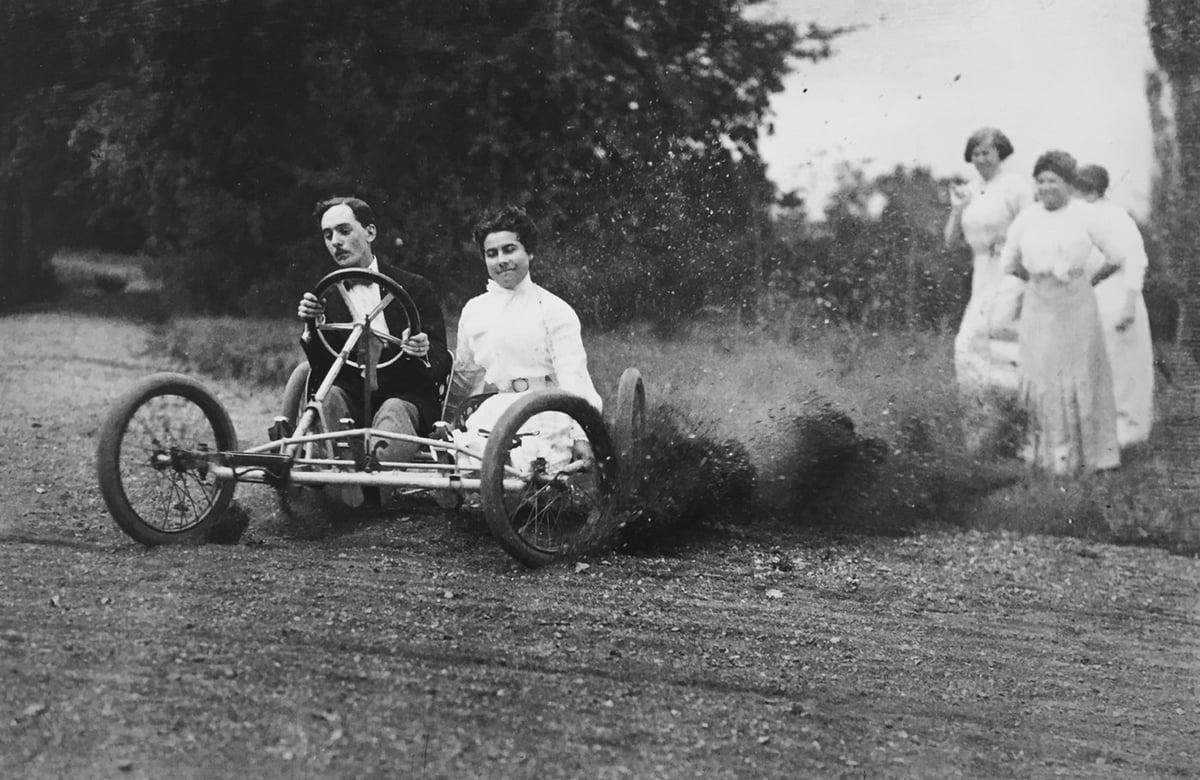
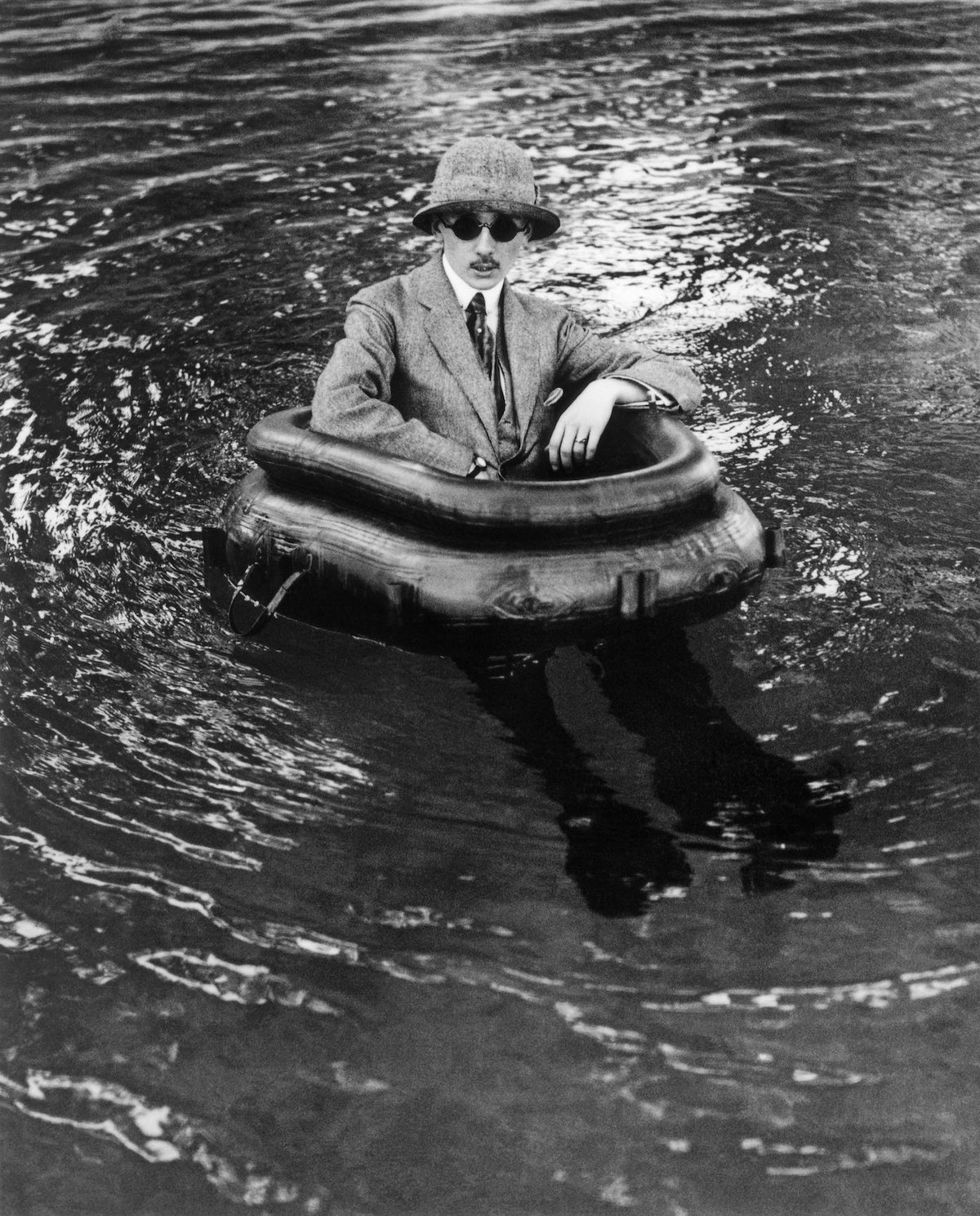
Born into wealth, Jacques Henri Lartigue got his first camera at age seven and began documenting the world around him: his friends and family at play in the world. His work presaged the “prolonged adolescence” of the “leisure class” readily on display on Instagram these days.
Taking pictures gave Lartigue a hobby and a purpose. His immediate surroundings and leisure class milieu provided the subject matter and Lartigue, a native user, wielded his camera with technical mastery almost from the beginning. He also brought a child’s whimsy to photography’s staid practice of posing and composing. Lartigue had a low vantage, a wandering eye, and a loose frame that was far ahead of his time. He also had the resources and time to experiment. Lartigue continued photographing prolifically into his teens and early adulthood, finding muses in his wives and mistresses and the diversions of prolonged adolescence.
Lartigue’s photography was an influence on director Wes Anderson, particularly in Rushmore and The Life Aquatic. If you can’t see Rushmore’s Max Fischer in the top photo of the homemade go-kart, you certainly can in this one:
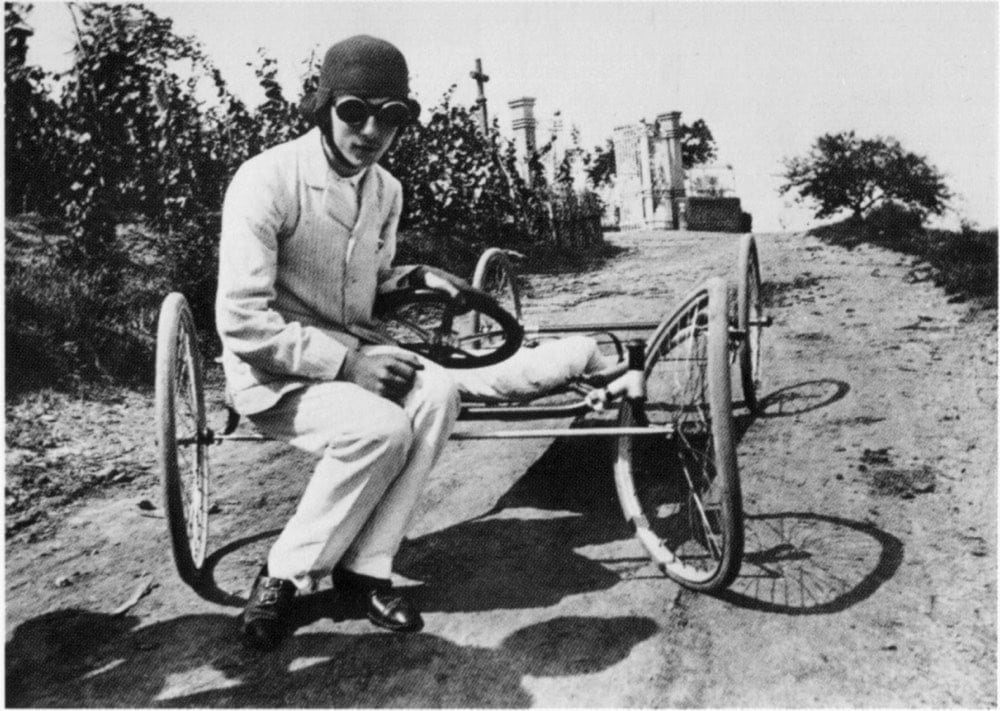
And the kid in the tire boat in the other photo? That is Lartigue’s older brother, Maurice. Everyone called him Zissou. (Curiously, none of this is in The Wes Anderson Collection. Come on! The photo of Zissou’s mentor Lord Mandrake in The Life Aquatic? That’s a self portrait of Jacques Henri Lartigue!)
DON’T deep fry gnocchi
If you’re like me from three minutes ago and you’ve never seen this video but want to laugh really hard, push play on this little number. You can safely skip ahead to about 0:33…that’s when the action starts.
P.S. Yo Kenji! Why does the gnocchi do that?! (via @essl)
Update: I have not gotten an answer from Kenji yet (to be fair, he just became a father), but the consensus on Twitter is gnocchi and popcorn share some similarities. I will let John Vermylen, who is a Stanford PhD and also runs the pasta company Zerega, explain:
Hydrated starch on gnocchi exterior gelatinizes with temp, forming impervious barrier. Temp builds up inside. Water tries to boil as temp rises, but can’t turn to steam due to barrier. So pressure builds up, which pushes against wall of gnocchi. Eventually high pressure forces crack in that wall, which leads to pressure drop and instant flash off of high temp water to steam.
There’s an opportunity here to make crispy popcorn gnocchi…which brave chef will take up the challenge?
Who Is This Restaurant For? A really interesting podcast series about restaurants, race, and culture.
Trailer for Errol Morris’ new documentary, The B-Side
Errol Morris’ documentary about portrait photographer Elsa Dorfman is coming out in early June and the first trailer was just released.
Errol Morris’s surprising new film is simplicity itself: a visit to the Cambridge, Massachusetts studio of his friend, the 20x24 Polaroid portrait photographer Elsa Dorfman, who specifies on her website that she likes her subjects “to wear clothes (and to bring toys, skis, books, tennis racquets, musical instruments, and particularly pets…).” As this charming, articulate, and calmly uncompromising woman takes us through her fifty-plus years of remarkable but fragile images of paying customers, commissioned subjects, family, and close friends (including the poet Allen Ginsberg), the sense of time passing grows more and more acute.
Adding “And Then The Murders Began” As The Second Sentence Of Any Book Makes It Instantly Better
Science is a fundamental part of America
Science in America is an impassioned video from Neil deGrasse Tyson about the threat we face from the political uncoupling of science from the truth in America today.
How did America rise up from a backwoods country to be one of the greatest nations the world has ever known? We pioneered industries. And all this required the greatest innovations in science and technology in the world. And so, science is a fundamental part of the country that we are. But in this, the 21st century, when it comes time to make decisions about science, it seems to me people have lost the ability to judge what is true and what is not, what is reliable what is not reliable, what should you believe what you do not believe. And when you have people who don’t know much about science standing in denial of it and rising to power, that is a recipe for the complete dismantling of our informed democracy.
Is Bugs Bunny black? What about Elmo? Or Optimus Prime? (It would be fun to do this with Jewish characters too)
These websites could change your life
I asked Kottke.org readers if they had ever seen, heard, or read something on the web that literally changed their lives.
Fourteen people said no. Sixteen said maybe. Thirty-eight people said yes. These are some of their answers. Everyone is anonymous. Some said more than others.
Four different people listed pages from Metafilter:
- Ask MetaFilter
- ;Where’s My Cut? —: On Unpaid Emotional Labor
- For the person who’s got everything: “I read this post, applied, and had a play made for me.”
- [creepy filter] Is it normal to become this distracted from seeing an attractive person in public?: This reader pointed to a comment in this thread “that describes the grinding reality of daily low-grade sexual harassment.”
Five readers listed works of journalism.
- The Lilly Suicides by Richard DeGrandpre.
- The Overprotected Kid by Hanna Rosin “persuaded me to be a far less uptight parent.”
- Is This Working? on discipline and punishment in the school system.
- The Blissfully Slow World of Internet Newsletters. (I hope this person now does something with newsletters.)
- Don’t report sexual harassment (in most cases) by Penelope Trunk.
Five listed personal essays or advice.
- Ten Things I Have Learned by Milton Glaser [PDF]
- Mindfulness in Plain English by Ven. Henepola Gunaratana.
- Encountering the Gifted Self Again, For the First Time “made me realise that I’m not just a weirdo, but all of my “quirks” actually fit together under a label, and that has made me understand myself about 10000x better.”
- Pixel Poppers: Awesome By Proxy: Addicted to Fake Achievement: “an essay on performance orientation vs. mastery orientation, as applied to videogame genres.”
- DEAR SUGAR, The Rumpus Advice Column #77: The Truth That Lives There.
Five listed videos or video series.
- “Almost any woodworking video by Matthias Wandel.”
- Vsauce.
- The School of Life
- The power of vulnerability by Brené Brown.
- Kid President’s Letter To A Person On Their First Day Here:
And ten listed entire websites.
- “Josh Davis’s www.dreamless.org message board, now defunct.”
- ”Violet Blue’s writing, which lead to me realizing sex is a much deeper and more interesting topic than mainstream news coverage would have me believe.”
- “The website MathPuzzle. It was the first time a website caught my attention and I corresponded with the owner/webmaster, and it opened me up to the online and offline community of puzzlers around the world. Working as a puzzle author got me through college and helped me establish a name for myself.”
- Bullet Journal.
- YearCompass.
- “Jeph Jacques’s Questionable Content, particularly how he dealt with suicide, depression, and the concept of people from different backgrounds so elegantly. I like to think it increased (and continues to increase) my empathy in the world.”
- National Novel Writing Month
- ”Radiolab made me want to be a journalist.”
- Université du Québec à Chicoutimi: “In 2005 I was trying to get information on how to study abroad for a year. Everything I read was on the Internet, and I then spent 9 months between 2006 and 2007 in Chicoutimi, Quebec.”
- Pixel Envy. “Not pandering. Started reading Kottke, DF, and Metafilter, and realized that I could try doing the same thing. I’ve had a modicum of success since, and met a bunch of really cool people as a result.”
Now pick up your instruments, and go start a band.
A short history of looking at data visualizations. It looks like our ability to make sense of them changes over time
The web’s best hidden gems
I asked Kottke.org readers to tell me what were the best web sites that they knew about that most people have never heard of. Normally, each of these sites would be worth a blog post on its own, either a longer or shorter one. But this week, we’re…
The rest of the suggestions are really quite something. I’d never heard of most of them. A few others I’ve loved and shared as a secret handshake between friends. In lieu of lengthy explanations, I’m just going to link them all and let you explore.
(This is what most web pages used to be: just long lists of links. We were such dorks back then. But maybe we were on to something.)
Note: The order is not a ranking, but simply an easy way I can count how many links there are.
Also Note: No money changed hands to feature any of these sites on Kottke.org, although in retrospect, that would have been a good idea..
Final Note: If the site required a login, or I couldn’t figure out what it was doing or why it would be interesting to anyone, I didn’t include it. Sorry.
- Weird Fiction Review: “an ongoing exploration into all facets of the weird, from the classics to the next generation of weird writers and international weird.”
- Pink Trombone: You kinda have to play with this one to get it.
- Internet Hockey Database: Statistics, Logos, and Trading Cards.
- diamond geezer: A lovely blog about trains and architecture in Great Britain.
- MLB Uniforms worn on April 19, 2017: You can do this for any date you want.
- Nepali: A Beginner’s Primer Conversation and Grammar
- Swear Trek
- Fuck You, Broccoli: “An in-depth exploration of vegetables and other so-called healthy foods.”
- Spacetrawler: A science-fiction webcomic and comics blog.
- Extra Ordinary: Another webcomic, about a little girl who has sweetly surreal adventures.
- WPC Probabilistic Winter Precipitation Guidance: Tracks snowfall.
- The Drawfee Channel: A video blog about drawing with digital tools.
- Is it Christmas?: Current answer: NO
- BoardGameGeek | Gaming Unplugged Since 2000
- Free online Dictionary of English Pronunciation - How to Pronounce English words
- Instant No Button! Unhappy Darth Vader on demand.
- Seismic Monitor: Recent earthquakes on a world map and much more.
- Autostraddle: News, Entertainment, Opinion, Community and Girl-on-Girl Culture. This site is great.
- Superbad.com: I… I don’t understand this thing I’m seeing.
- WWWF Grudge Match - Where useless knowledge breeds champions: If you’ve ever wondered, “What if Boris Yeltsin and Ted Kennedy had a drinking contest?” this site is for you.
- The Griddle: A puzzle blog with free puzzles.
- Badger Badger Badger.com! The Original Dancing Badgers!
- Futility Closet - An idler’s miscellany of compendious amusements
- Skyline - YouTube: “Esports analyst and coach focusing on the game Overwatch.” Two people suggested this.
- The Vintagent: A vintage motorcycles blog.
- CDC WONDER: The CDC’s online databases. Get as much government data as you can, while you can.
- InfiniteLooper: Endless loops of YouTube videos.
- The Morning News: A real blog. I love it.
- Deadspin’s The Stacks: Old sports stories from out-of-print magazines republished with the author’s permission. I can’t believe I hadn’t been reading this already.
- street dog millionaires: Two dogs, one from India, one from Africa.
- FL@33 presents http://bzzzpeek.com: What do animals sound like in different countries? (Every language is different!)
- JazzOasis.com - Pat Metheny on Kenny G: Jazz guitarist Pat Metheny takes Kenny G to the woodshed.
- McMansion Hell
- Scroll Down to Riker: Does what it says on the tin.
- Flickr: The Commons
- NYPL Digital Collections: This is amazing, and it’s all free to play with.
- The Library of Babel
- Bowiebranchia: “Nudibranchia or other opisthobranchia compared to the various looks of David Bowie.” Surprisingly compelling!
- Play Later: Browse newly released albums and save them for later. Mostly a handy discovery frontend for Spotify.
- www.Visual6502.org: Simulation of vintage computers and game systems in the browser.
- Political status of Western Sahara: So are we going to have a new country in North Africa or what?
- Antipope - Charlie’s Diary: Science fiction writer Charlie Stross’s blog.
- Pi.co: Interviews with interesting people by journalist/investor Om Malik.
- Deuce of Clubs: A Demonstrated Aptitude for Reasonable Mayhem: A site by Godfrey (“Doc”) Daniels, of Mojave Phone Booth fame.
- The Well’s annual conversation with author Bruce Sterling.
- Beyond the Frame: visual essays about TV and movies by Luis Azevedo.
- Artsy Engineering: An information network and open-source software for people in the art world.
- Hart Island Project Stories of unclaimed and unidentified people buried in mass graves in an island near New York city beginning in the 19th century.
- Damn Interesting: a science, history, and psychology blog.
- What’s Noka Worth? (Part 1) — DallasFood. A takedown of a hot, expensive artisanal chocolate maker… over a decade ago.
- Mexican Table Salsas: The eGullet culinary institute’s discussion of traditional salsas, and how to make them.
- Histography - Timeline of History: A mighty timeline view of every event in Wikipedia. That’s a lot of dots.
- People Reluctant to Kill for an Abstraction, a movement: a short story/manifesto by George Saunders.
- Langscape: an interactive map of all world languages, put together by researchers at the University of Maryland.
- in Bb 2.0 - a collaborative music/spoken word project: twenty musicians, all playing in the same key — you get to mix and match.
- Paper Planes: Use your phone to catch and throw paper planes to and from people all over the world.
There! That ought to be enough magic and wonder to last you through the weekend. Thank you, as always, to the readers who submitted links.
Welcome to the only show in town

[From Achewood, by Chris Onstad]
It’s never good when someone calls you on the phone to tell you that someone you love has died. It’s like those scenes on TV shows where the police or the White House are rushing to notify the family of the deceased before the news breaks so that they don’t learn about it from the television.
I’ve had it happen for three people in my life who weren’t close friends or family members: George Carlin, Steve Jobs, and Prince. In each of those cases, someone heard the news first and thought of me. This may be the sweetest and most melancholy kind of kindness. Today, it’s been a year since Prince died.
Prince made music for as long as I was alive. His self-titled album, made when he was still a teenager, was released the week before I was born. My mother, who loved Prince as much as I did, listened to “I Wanna Be Your Lover” over and over again when I was in utero. Prince and his music were Facts of the Universe, like the ancient Greeks believed in Zeus and his thunderbolts.
The only star as big and bright was Michael Jackson, and you couldn’t go into your room and put on headphones to listen to Michael Jackson’s dirty songs where nobody else could listen. It was a different kind of intimacy and intensity.
Added to my collection: 3.5” floppy given to press when Prince changed his name. Contains a font w/ one symbol in it. pic.twitter.com/mNL0eOHDGI
— Anil Dash (@anildash) June 23, 2014
Michael Jackson’s and Whitney Houston’s deaths felt different: a Kaddish for lost dreams in childhood, a renewed awareness of how fragile these larger-than-life figures always were. Lou Reed’s and David Bowie’s deaths felt different: mourning my teenage self, my teachers and heroes. Prince’s death was like losing the love of my life.
The web has an unusual and still-evolving relationship with death and mourning. People have always used it to memorialize people they loved, and to learn more about them. (One of my first contacts on the web was someone looking for information on a relative with my first and last name who went missing in action in Vietnam.)
But the systems of the web were slow to catch up. Social networks built to stalk college classmates only gradually learned how to deal with members’ deaths. Who owns or can access your virtual assets and information after you die?… It depends. The mechanisms we’ve built aren’t built for this. Hopes for the Singularity aside, there’s no disrupting death.
We are inventing new rituals of public mourning online. And when it comes to death, rituals may matter as much or more than network topologies and the law. In many ways, these rituals replace older ones we’ve lost. Grief once expressed in public via mourning clothes, black armbands, and semi-public funerals is now being hashed out on the web.
“I really believe that a lot of these social media mourning rituals are popping up because people aren’t able to mourn in public spaces the way that they used to,” says Candi Cann, an assistant professor at Baylor University and author of “Virtual Afterlives: Grieving the Dead in the Twenty-First Century.” “People have this need to be recognised as grievers.”
We can’t always be with family, scattered across countries and continents. We can’t always confide in old lovers, our relationships fraught and fractured. We can’t take off from work to curl up and cry in private without consequence. We can’t all make pilgrimages to leave votive offerings and memorabilia at the sites of death.
But we can tell friends and strangers how we feel. We can point them to the things this person made that changed our lives. We can let them know, friends and strangers both, that it is okay for them, for us, for all of us to feel, to mourn the person and what that person meant. To mourn the part of us that will never be the same without the other person’s presence exerting a magnetic pull on us from across the planet.
(With thanks to Anil Dash)
The web is a portal to other worlds
Like I mentioned in the post on web comedy, something about the experience of the World Wide Web, the experience of working with a screen, seems to loosen our hold on reality. Maybe we’ve trained ourselves to do it by reading stories and playing video games with very vague visual details (sometimes just text). Maybe it’s part of blocking out the world around us so we can focus and interact on the screen. Maybe it’s a residue of the awkward metaphors of “cyberspace,” or maybe this is where those metaphors come from. But I think we are amenable to the suggestion of a possible world where everything is different, even more so than when we read a book or watch a movie. The closest thing might be comic books, which likewise play endlessly with time travel, alternate universes, and what-if scenarios.
“Rome, Sweet Rome” is a short story that began as part of a Reddit thread and eventually turned into a movie deal. It’s about a modern US Marine Corps unit that gets sucked back in time and fights Roman soldiers in 23 BC. It’s just like one of the thousand of ridiculous “what if?” conversations that take place on the web every day. But it’s also something that the people who were involved with it while it was being made never forgot.
A People’s History of Tattooine is something I was involved with, although someone else nominated it for part of the time capsule. In 2014, a bunch of geeky dads (mostly) on a Saturday started to wonder how the Star Wars stories would be told not by the Rebellion or the Empire, but by the nonhuman people seen throughout the series. In other words, as Jake Harris wrote, “what if Mos Eisley wasn’t really that wretched and it was just Obi Wan being racist again?”
This attitude, which treats almost nothing with reverence, but everything with care for its consistency and its consequences, is one of the fundamental modes of being on the web. It’s not like traditional fandom, scholarly pedantry, or manual-driven computation, where the original texts are treated like sacred writ. It’s fanfic, it’s slashfic, it’s deconstruction, it’s inventing your own entire fork of a standard because the standard doesn’t do what you think it ought to do. And it’s an attitude particularly well-suited for world-building.
The Onion imagined a film script that had been floating around Hollywood for 75 years called The Final Symphony, with a part written for Basil Rathbone that was later “rewritten for Mickey Rooney, and later Gene Wilder and then Chris Tucker.”
SB Nation wrote an entire feature imagining quarterback Tim Tebow’s sojourn through the Canadian Football League, little imagining that he would do something even less likely and take up minor league baseball.
The Beatles have two alternate histories that readers nominated: one, a Borgesian counterhistory where the band never broke up (complete with unexplained artifacts from that universe), the other, a timeline of events where The Beatles accepting Lorne Michaels’ stunt offer to reunite on Saturday Night Live leads to a reunion album, Mark David Chapman’s suicide, Michael Jackson’s premature death, and Lennon protesting the second Iraq war.
Dru Johnston’s “I Think I Should Get More Credit For Killing Hitler” shows that in a utopia as well as a dystopia, the gods are indifferent to our heroism.
Finally, there’s the case of Walter Miller’s Homepage. Walter Miller was basically dril before dril. Same dark humor, same misspellings, same grim, bizarre universe, same cult reverence.
The homepage began as a Prodigy site in the mid-1990s at the URL pages.prodigy.com/Hell/walter. It appeared on Suck in January 1996, it was in Time magazine, it won awards, the Harvey company optioned it to be an animated series.
Nobody, as far as I know, ever figured out who Walter Miller was, whether he/she/they were just one person. The site just… faded away. Except it’s mirrored and hosted by fans all over the web, sometimes in different states: an entire sea of alternate versions of an alternate universe, waiting to one day be made whole again.
“Perhaps muppetness is a genetic mutation to which both humans & animals are susceptible?” On the origin of Muppets
Is PowerPoint Turing-complete? Someone built a few Turing Machines (tape & everything) as presentations to find out
Cormac McCarthy on the unconscious/animal origins of language. First nonfiction publication; still reads like him
How can we save the digital pieces of our hybrid lives?
My friend Brian McCullough is an internet historian and podcaster. In this blog post, he takes my idea of a time capsule for the World Wide Web containing the best examples in different forms and flips it on its head.
When I go to Google Maps and look up my old block, if I go to street view, I can see what feels like a nostalgia miracle now: a picture of me and my now-deceased dog walking into Prospect Park, like we did a thousand times. I remember the day it happened. Noticing the Google Street View car just as it passed us. Wondering if it captured us.
It felt like a lark at the time. Now it feels powerfully meaningful. Proof, somehow, in the vast historical Matrix of the Internet, that Winston was my dog. And we went for walks in the park in the afternoon. And he was a good dog. And they were GOOD, those walks. I miss those walks.
We all know that, more and more, Internet life IS real life. The important, consequential, meaningful things that happen to us increasingly have a digital record; and that’s if they haven’t, in fact, ACTUALLY happened online! So you, reading this right now, probably have 3-4 things that are treasured heirlooms from your digital life that you would save from a digital fire.
And he ends it with this amended version of the time capsule challenge:
Ask your readers to submit some of the most profound, history-changing, this-is-when-my-life-changed PERSONAL moments that are on the web. That upload. That status update. That selfie. The digital, “personal effects,” as it were, that they would save from a fire.
And this is true. If your house was on fire, you wouldn’t save your copy of the collected works of Shakespeare. (Maybe if, for some reason, you have a copy of the First Folio in your house.) You’d save your printed photo albums. You’d save your phone and laptop, the devices that (even if they’re backed up to the cloud) hold the irreplaceable pieces of your life.
It reminds me of this old episode of Radiolab, where Ann Druyan talks about recording the Voyager Golden Record. Along with Mozart and Bach and Chuck Berry, and audio recordings of the major human languages, it includes a recording of her brainwaves, right at the time that she and Carl Sagan were falling in love.
The difficulty, as Brian points out, is that so much (not so little) of our personal data is recorded and stored forever, and stored in huge data silos where we have little access to it, and few ways to curate and preserve it and pass it on ourselves.
I don’t have a solution, to either problem. I know that both problems are at a new scale, even for the World Wide Web. When we first began to blog and scan and document our lives, we weren’t quite capable of imagining how different the collection, storage, and recall of data were going to become. It’s like moving from (slow) Newtonian to (fast) non-Newtonian speeds: the regular laws of physics no longer apply.
And this means that the regular laws of history no longer apply, either. We might have relatively limited insight into individual lives or works, no matter how noteworthy those individuals might be, compared to the massive databanks of all lives and all information sources stored by Google, Facebook, Microsoft, and Apple. If only we could get our hands on it.
The web’s funniest stories
I asked Kottke readers to tell me the funniest stories they’d ever read on the web.
Now let me say this: I like to think I have a pretty eclectic sense of humor. I can go high or low, folksy or surreal, G-rated puns or X-rated filth. But some of you… let’s just say a few of you surprised me with some of this. This is some seriously weird shit.
NOTE: To narrow things down, I knocked out anything that didn’t resemble a story. I knocked out videos and focused on text. People who suggested comedy specials on Netflix — I didn’t watch those. I eliminated anything that seemed downright stupid, mean, or just not funny. And I probably dropped a few other links here and there because I closed the tab instead of saving it, or some other reason. This isn’t a scientific survey; this is a blog.
- “So You’ve Decided To Drink More Water,” by Mallory Ortberg. This is pre-Toast Mallory, and it has everything that made her a huge star in the years that followed. (Well, at least a huge star for us.)
- “Dogs Don’t Understand Basic Concepts Like Moving,” by Hyperbole and a Half’s Allie Brosh. It’s true. They don’t.
- “Climb Aboard, Ye Who Seek the Truth!” by Bronwen Dickey. A cruise for conspiracy theorists. Or, if you will, a “Conspira-Sea Cruise.”
- “Downton Abbey With Cats,” by John Hodgman. It’s not a laugh a minute, but this story has a core of melancholy that just makes it deeper and funnier over time.
- “Darling, There’s Something I’ve Been Hiding From You—I’m Jimmy Buffett.” Surprisingly, there was only one entry from The Onion, but it’s a pretty good one.
- “Everything That’s Wrong of Raccoons,” by Mallory Ortberg. This is right at the end of The Toast’s run, and it’s a treat. “I can’t be in trustment of a beast that clambers and waddles both.” Nor should you, Mallory.
- “The Wisdom of Children,” by Simon Rich. I think the best part of this is the adults’ table conversation as imagined by the kids’ table, but opinions may differ.
- “An Oral History of ‘Mad Men’,” by Clickhole. The oral history boom kicked off a terrific run of oral history spoofs by Clickhole. The one for Radiohead’s OK Computer and Michael Jordan’s flu game are also excellent, although after a few, they start to feel kinda samey.
- “TIME FOR SOME STORIES,” by davesecretaryatwork. This is one of those “maybe you had to be there” things, but these set of stories were lovingly carried over from the VivaVinyl.org message board to an Angelfire site that then went down, and finally found a home at somebody’s tilde.club page. Also, two different people nominated it. Who are we to judge what cracked people up in the days before YouTube?
- “An Insider’s Report on the Death of ‘Wilton North’,” by Paul Krassner. This seems like something somebody could have made up, Spinal Tap-style, but in the very early days of the Fox Network, there really was a short-lived late night TV show called The Wilton North Report. Conan O’Brien, Greg Daniels, Alex Sokolow, and other future luminaries wrote for it. I swear to god.
- “Oscar Fug Parties: Lindsay Lohan and Sharon Stone,” by Jessica Morgan. This is now a different kind of funny given the future career arcs of these two actors.
- “Something Close To Madness Case File #24: The Oogieloves In The Big Balloon Adventure,” by Nathan Rabin. A screening of a very strange kids’ movie gets even stranger.
- “The story of Amun-Re, the crappiest god ever,” by Joe Gola. I’ve never played the board game this is based on, but this is an inspired bit of message board fan fiction.
- “The Pitch Meeting for Animaniacs,” by Abbey Fenbert. “EXEC #1: How will kids feel when they watch this show? THE ANIMATOR: Disconcerted. Unmoored. Hyper-stimulated. Amused to the point of terror.” This is so good.
- “In Which I Fix My Girlfriend’s Grandparents’ Wifi And Am Hailed As A Conquering Hero,” by Mike Lacher. Maybe the most McSweeney’s story that ever McSweeneyed.
- “TOTO’S ‘AFRICA’ BY ERNEST HEMINGWAY,” by Anthony Sams. On second thought, maybe the competition for Most-McSweeney’s is stiffer than I thought.
- “My 14-Hour Search for the End of TGI Friday’s Endless Appetizers,” by Caity Weaver. Maybe the most memorable bit of nu-gonzo reporting of this decade. New Journalism had acid trips: we have mozzarella sticks.
- “The Alameda-Weehauken Burrito Tunnel,” by Maciej Ceglowski. This was 2007, but I say if we’re not building hyperloops to send authentic California burritos across the country, then I don’t see the goddamned point.
- “Anecdotal Leads for News Stories Reporting the End of the World,” by Hart Seely. Newly timely! When a friend recently passed this along again, I reached the end and laughed out loud for a full minute like, well, someone who’s facing the end of the world.
There’s still something to be said about the kind of humor that the web makes possible, or at least rewards disproportionately to other kinds of media. There’s definitely more short-form, densely-referential bits that somehow fuse tweeness and gallows humor than you see on television, or even in magazines, which might be their nearest successor. Some savage blend of The New Yorker and underground zines.
It’s a little like what happened to television comedy after The Simpsons showed up. Animation opened up the possibility space for other kinds of comedy, found a way for the weirdest bits of Get Smart and Monty Python to exist in their own separate universe.
The web had a similar effect. You could write anything. You could do anything. No sets to build, no pages that had to be filled. You had endless reflections by comics on podcasts and interviews and their own blogs and social media feeds about what made the funniest things funny. There were all sorts of new media genres you could lampoon, pillory, and steal from on the sly. You had greater collisions than ever before of different people from all over the world and every walk of life who brought their own traditions of humor and storytelling. Amateur and up-and-coming jokesters desperate to connect with friends and strangers. And an audience chained to their desks or stuck on a train or a doctor’s office looking to laugh. That’s just good gumbo.
Sometime in the past decade, “woke” pop culture criticism became the norm, even in outlets that once resisted it
Apparently, there was an enormous food fight in the CIA cafeteria in 1965? leading to “three or four” firings
The web’s most useful tools and sites
The World Wide Web isn’t all fun and games. This isn’t television! This isn’t an arcade! This is computing! We’ve got high-powered work machines tuned into this thing! With keyboards and mice and productivity software and everything!
These are the most useful tools and sites on the web, as nominated by the readers of Kottke.org:
WORDS
Thesaurus.com
Linguee
Online Etymology Dictionary (three different people suggested this! which suggests to me that y’all are my kind of people)
Green’s Dictionary of Slang
Behind the Name (which is a baby name site I think?)
Wiktionary
OneLook
TIME AND WEATHER
Time.is
Time and Date
Weather Underground
ABC 13 Southeast Texas Weather (from a reader who lives in Houston)
National Oceanic and Atmospheric Administration (this site is very cool)
KNOWLEDGE REPOSITORIES
Baseball Reference
Stanford Encyclopedia of Philosophy
Wikimedia Commons
Wikipedia
Old Maps Online
Internet Archive/Wayback Machine
BOOOOOOOM
CONTENT DISCOVERY
Digg
Nowness
Metafilter
Kottke (you’re already here)
Can I Stream It?
TV Muse
CODING AND DESIGN STUFF
Tampermonkey
Stack Overflow
CopyPasteCharacter
Cool Tools
0 to 255
Wordmark.it
Random Password Generator
Google Fusion Tables
SAVE IT FOR LATER
Pocket
Ffffound!
FutureMe.org (write a letter to yourself in the future)
SOLVING UNUSUAL PROBLEMS
This to That (Glue Advice)
Soapcalc (Making soap)
waifu2x (Anime character generator)
Random Oblique Strategies Online
BROWSER EXTENSIONS
Shut Up (hides comments)
OneTab (collapses all your browser tabs into a sortable, exportable list)
SEARCH ENGINES
Google, Craigslist, DuckDuckGo, the usual crap
A lot of you seem like you have really cool jobs.
(A special thank you to Google Forms for making this possible.)
Jay Smooth’s Ill Doctrine is still the best
It’s 2008. George W. Bush is President. The Democratic primaries have just ended, and Barack Obama is the unlikely presumptive nominee. The economy is circling around the drain, and America is about to have its first black Presidential nominee by a major political party.
I don’t know exactly how you might measure and graph a country’s level of plausibly deniable racism or awkward attempts to identify or discount such racism, but if you could, summer 2008 would have to be one of its peaks.
That’s when Jay Smooth posted “How To Tell Someone They Sound Racist,” one of the greatest videoblog entries of all time.
Jay’s video turned into a TED Talk and a video series for Fusion called The Illipsis.
But mostly, he’s still hosting WBAI’s Underground Railroad (since 1991!), keeping up his site HipHopMusic.com (not much lately, but he started it in 1997!) and writing blog posts and making consistently great videos about music, race, politics, and culture at Ill Doctrine.
Watching Ill Doctrine is to feel the power and pleasure of seeing a mind at work. He’s always thinking around seven or eight sides of an issue and following them through all the way to the end. He does what you might call “explainers” but without any of the condescension to the audience or pretense to having settled an issue once and forever endemic to the form. It’s conversation.
He’s the best editor of any weblog I know — every cut is a new thought, a new idea, a new argument to hang on the thought right before it, and the cumulative effect is like a cubist painting.
He’s still experimenting with the format, adding interviews, letting his cat co-host, always oscillating between the public and the personal. Jay’s still the best at what he does.
Update: Jay just launched a Patreon campaign to keep Ill Doctrine going well into the future; if you love his work, please consider supporting it.
The only tweetstorms worth saving
Most tweetstorms are perfectly harmless, some are downright satisfying, and only a few make us seriously consider gouging out our own eyes. But — how shall I put this? — there is a reason most of them were not written in a form that encourages long preservation of the entire thing. Even the better Twitter threads are very much of the moment. They were not built to last. Nor should they have been.
Luckily, there are exceptions. Here are some of the tweetstorms/multiperson twitter threads that Kottke readers voted to include on the World Wide Web’s space ark.
Please Stop Roasting My Goddamned Shoes. Comedian Jon Hendren found a pair of red Vans with a leopard print lining in the back of his closet. Did his fellow comedian friends let this pass without comment? No, they most certainly did not.
If you’ve never read “Please Stop Roasting My Goddamn Shoes,” buckle up. If you love it, check out its best rival/nearest successor, @spookperson’s “my dude looks like the babadook” thread roasting Roger Stone.
The Two Mayors. The climax of Dan Sinker’s epic story of @MayorEmanuel, an alternate-universe version of then-candidate Rahm Emanuel and unabashed love letter to the city of Chicago. This is actually the day before the election, where alt-Rahm meets then-Mayor Daley, learns that he isn’t the only Rahm Emanuel in this universe, and that Chicago’s mayor has cosmic responsibilities never hinted at in public. This twitter thread, played out over months, eventually became a terrific book.
@MayorEmanuel’s final official tweets also deserve to be saved, so here they are:
I can see a thousand fucking skylines, and they are all as motherfucking glorious as the first, and I can feel the touch of my friends.
— Rahm Emanuel (@MayorEmanuel) February 24, 2011
And now all I can hear is that music, and suddenly everything just fucking…
— Rahm Emanuel (@MayorEmanuel) February 24, 2011
“A Wild Weekend In Florida,” or “Zola’s Story,” by Aziah King It’s never been entirely clear exactly how much of any of this really happened, but the microserialized true-crime story was and is a bona fide phenomenon. “A Wild Weekend” also uses breaks between tweets better than any Twitter story I’ve ever read — most tweets are perfectly self-contained, but a few of them are used to build suspense or cut from one moment to the next to great effect.
This tweetstorm has a Goodreads entry. It was optioned for a movie. That’s some real game theory.
Golden State Warriors coach Steve Kerr has an amazing story, and it’s well-told in this long profile
Pour some out for the sites that aren’t here
Some of the best things ever seen or used on the web can’t be saved. They’re already gone. These are some of them, nominated by Kottke readers.
Google Reader. On the one hand, Google kind of ruined RSS, up until then the best distribution method for serial content, by turning it into a product. At the end, some of the best RSS readers weren’t even RSS readers, just frontends for Google Reader, which handled all the resource-intensive work.
On the other hand, Google Reader was a really wonderful community. It had a lightweight social graph component, but it was really oriented around news and stories and blog updates that people shared. Everything that people wanted online comments to be, Google Reader was. And when it ended, it took all of that away, leaving social media networks — which were really never designed to do content distribution — as the only game in town. I honestly don’t know if we’ve ever recovered.
Geocities. Geocities was a lot of people’s first experience making and reading home pages, putting their lives, personalities, contact information, getting email addresses, and anything else they wanted to share out on the web. The “cities” conceit made it sortable and browsable: they weren’t quite geographical and weren’t quite thematic, but a weird combination of the two. It got bought by Yahoo, back when Yahoo was buying and blending everything, and went the way of all such things.
Now Geocities exists only in Japan, but, like a lot of “first websites,” you can emulate it if you want using Glitch. As Anil Dash writes, “millions of people created their own websites in the era before today’s social networks took over. Learning to tweak HTML to create a GeoCities page, or to customize CSS to make a MySpace page look perfect, was a rite of passage for the first 10 or 15 years of the web.”
Think Secret was an early tech blog focused on Apple, back when Apple was very far from the biggest company in the world. Writing and reading about it, especially rumors about new products, was just a weird obsession for a handful of people. Anyways, Think Secret and its editor Nick “de Plume” Ciarelli got sued for violating trade secrets, and Think Secret was shut down as part of a settlement right as the iPhone was turning Apple into the company everybody was talking about all of the time. Things break another way, and that site’s worth millions of dollars today. Then again, that didn’t save Gawker — so who knows.
Television Without Pity practically invented the genre of TV episode recaps, starting with Dawson’s Creek. Now they’re everywhere! It got bought by NBC in 2007 and shut down in 2014, but supposedly it’s coming back. We’ll see. Nope, turns out it’s just the shell of the website; TWOP won’t running new material after all. But the founders of TWOP went on to start previously.tv. (Thanks, @adrienneLaF, @michelet.)
Nothing lasts forever on the World Wide Web. Even death.
Update: So many people, after this story went live, answered “what about Suck.com?” that I had to make an update.
Reading Suck is bizarre now, because on the one hand, its wry, teasing, sweetly cynical voice has shaped so much of what we know of the web, but its style is actually quite different. It’s like reading Don Quixote and realizing that Cervantes’s book somehow contains, in miniature, every novel that came after it, but that it is also somehow older and stranger and more imaginative than all of them. Also, that every tech or media hype or hustle is exactly the same as one that happened twenty-odd years before it. This is why reporters who’ve been covering Silicon Valley forever have such a twisted sense of humor.
Anyways, the archive still exists; the best way to get it, in my opinion, is the Suck Again email newsletter, which posts every instance of Suck twenty years after its original publication date. Suck is dead; long live Suck.
What Is Digital Humanism?
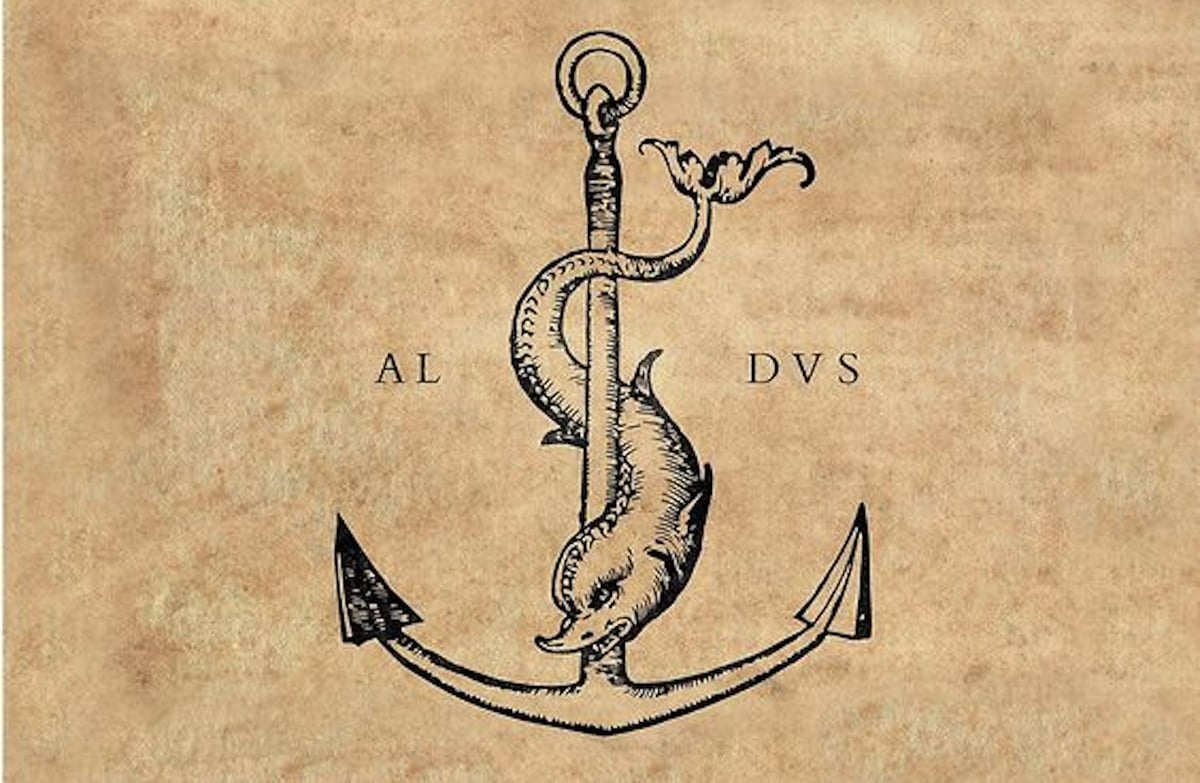
In this century, most people use “humanist” to mean something like “atheist, but nice about it.” That’s not what I’m talking about. I’m thinking about Renaissance Humanism, but applied, updated, or translated to digital technology in the 21st century.
In the Renaissance, Humanism is a complicated umbrella term for different, sometimes contradictory intellectual movements. The most consistent attributes in these humanists are these three things:
- they were really into old books and manuscripts, the weirder the better;
- they tried hard to save and preserve these texts;
- they worked hard to disperse these texts and the ideas inside them to as many people as possible.
And once the printing press came along, they were off to the races.
Aldus Manutius might be my favorite humanist who didn’t write very much. He edited and published classical texts in slim, portable, affordable printed volumes, and invented or popularized a bunch of typographical conventions, like italics, commas, and semicolons.
In the metaphor of the all-in-one machine, Humanists were first and foremost scanners. They translated knowledge from one technology, and its attendant modes of thinking, into another. They took old things and made them new.

[From Planetary by Warren Ellis, John Cassaday, and Laura Martin]
All of the genuinely great works of the 21st century have been acts of digital humanism. And of those works, three stand out as the purest and maybe the best, both to me and (in their suggestions) the readers of Kottke.org.
Wikipedia, Google Books, and The Internet Archive. These three projects, imperfect as they are, are the best attempts we’ve made to save what we know and make it available in new forms to as many people as possible.
Here are some other projects that readers mentioned:
- Project Gutenberg offers free digital copies of books in the public domain.
- RECAP makes public legal documents more accessible to nonlawyers.
- UbuWeb is a digital archive of writing and other art that leans conceptual or avant-garde.
- Newgrounds is a Flash games and animation site I spent way too much time on in the mid-2000s.
- The Internet Review is a project that reviews web trends and events from the year before and turns them into a printed book, and was a big influence on this idea of a time capsule for the web. (More of a “print” than a “scan.”)
- Colossal is a visual culture blog with an emphasis on handmade art and design.
- Pastebin stores code and other text for easy sharing.
- Pinboard is a social bookmarking site that’s still independent and still going strong.
- Github is the best place to find and make open-source software.
- The Lively Morgue is a New York Times project to upload photos from its archives.
- The Electronic Frontier Foundation does the legal work to protect individuals and the commons’ digital rights.
- We’ve already talked about Flickr. And I’m sure we can list many more.
Every day, sometimes visibly and sometimes not, people work to save all of the things we’ve built on the web. It’s probably the most massive, audacious, unlikely project in the history of the written word. If we ever do build a time capsule for the internet, we’ll only have anything left to save because someone else worked to save it first.
Ze Frank’s “The Show”
For a few weeks in 2006, people would ask me, “have you seen ‘The Show’? It’s the best thing ever,” and I would answer “Of course! I love it!” But I was talking about this:
It wasn’t until Ze Frank got a lengthy writeup in the New York Times (10,000 daily visitors!) that I realized they were talking about something else. And when I asked Kottke readers to nominate something to put in a time capsule for the World Wide Web, more people suggested Ze Frank’s The Show or episodes from it than they did anything else.
The Show helped establish some enduring conventions for videoblogging: direct address, quick cuts, slightly varied closeup angles, and a curious mix of oversharing, motivational speaking, political commentary, and nerdly zaniness, You never knew quite what you were going to get, but for that one year it ran, you knew you could get it every day.
If the earth was a sandwich We’d get along so well And we could feed everybody With a piece of ourselves
Ze brought The Show back for a short spell in 2012: “An Invocation for Beginnings” was a favorite video of a number of people who wrote in suggestions.
And for years now he’s helped run video at BuzzFeed — where a lot of The Show’s aesthetic can still be found, especially that relentless drive to figure out “what can I do to get people’s attention today?”
Future generations might take a minute to sort out the time-dependent references and figure out why these videos were so compelling. (They will also drop their jaws in wonder at just how old the computers from 2006 now look.) But that drive-for-attention/drive-for-connection part? I bet they’ll understand that part just fine.
The best tweets ever (nominated by Kottke readers)

god: i have made Mankind
— u have won a bear (@jon_snow_420) October 28, 2015
angels: you fucked up a perfectly good monkey is what you did. look at it. it’s got anxiety
Twitter, in principle, could have been invented at any point in the history of the internet. A big networked message board with an upper limit of 140 characters? It sounds like something a resource-conserving developer would have invented before web browsers existed. A few hundred people would have used it, and it would have been legendary. Maybe a few thousand.
A translation guide for software engineers (by btco@) pic.twitter.com/cOlVCmdne6
— Ikai Lan ???? (@ikai) June 1, 2014
Instead, Twitter happened in the early days of developing for mobile devices (originally, not even phones but pagers), when there were a critical mass of intense and casual users, and mass network graphs were quickly becoming the new hotness for software companies. You could get scale in a hurry, you needed scale after a certain point to survive.
First full day as Twitter COO tomorrow. Task #1: undermine CEO, consolidate power.
— dick costolo (@dickc) September 13, 2009
And so we have this bizarre new communication platform-meets-vernacular art form. Which may end up killing us all. But first…
Everything happens so much
— Horse ebooks (@Horse_ebooks) June 28, 2012
Jason joined Twitter in early 2007 and naturally, wrote about it intelligently and presciently here on Kottke.org. The first mention is in a kinda-sorta-liveblog of Steve Jobs’s legendary iPhone keynote, and makes Twitter sound like a new tech site. This is where I, personally, found out about it, although I didn’t sign up until a little later.
Playing with Twitter reminds me of blogging circa 2000. Back then, all weblogs were personal in nature and most people used them to communicate with their friends and family. If I wanted to know what my friends were up to back then, I read their blogs. Now I follow Twitter (and Flickr and Vox).
The reaction to Twitter mirrors the initial reaction to weblogs…the same tired “this is going to ruin the web” and “who cares what you ate for dinner” arguments…
When one thing (i.e. Twitter) is easier than something else (i.e. blogging) and offers almost the same benefits, people will use it.
As you might know, I am a full time Internet
— Horse ebooks (@Horse_ebooks) February 24, 2012
I’d completely forgotten about this post, and it’s totally amazing.
[One] way of thinking about how to choose web projects is to take something that everyone does with their friends and make it public and permanent. (Permanent as in permalinked.) Examples:
- Blogger, 1999. Blog posts = public email messages. Instead of “Dear Bob, Check out this movie.” it’s “Dear People I May or May Not Know Who Are Interested in Film Noir, Check out this movie and if you like it, maybe we can be friends.”
- Twitter, 2006. Twitter = public IM. I don’t think it’s any coincidence that one of the people responsible for Blogger is also responsible for Twitter.
- Flickr, 2004. Flickr = public photo sharing. Flickr co-founder Caterina Fake said in a recent interview: “When we started the company, there were dozens of other photosharing companies such as Shutterfly, but on those sites there was no such thing as a public photograph — it didn’t even exist as a concept — so the idea of something ‘public’ changed the whole idea of Flickr.”
- YouTube, 2005. YouTube = public home videos. Bob Saget was onto something.
I’m sorry Ms. Jackson (Oooooo)/ I am four eels/ Never meant to make your daughter cry/ I am several fish and not a guy
— j. nalven ???????? (@JNalv) February 20, 2013
Some successful tweets seem predictable given the restrictions on the form — wordplay, pop culture mashups, classic setup-and-punchline jokes. But why are weird little micronarratives so compelling?
i fear my tropical fish no longer respect me after i accidetnally stumbled backwards & smushed my ass hole right up against their $3000 tank
— wint (@dril) March 20, 2017
TSA agent (checking my ID): “Hawk, like that skateboarder Tony Hawk!”
— Tony Hawk (@tonyhawk) March 21, 2017
Me: exactly
Her: “Cool, I wonder what he’s up to these days”
Me: this
And on a platform packed with self-promoting brands, cynical media types, and actual Nazis, why do we love sweet, sincere animals who talk? (Wait, I may have just answered my own question)
This is Pipsy. He is a fluffball. Enjoys traveling the sea & getting tangled in leash. 12/10 I would kill for Pipsy pic.twitter.com/h9R0EwKd9X
— WeRateDogs™ (@dog_rates) November 19, 2015
@brant they’re good dogs Brent
— WeRateDogs™ (@dog_rates) September 12, 2016
Ten years later, I don’t know why Twitter is, but I’m glad that it does.
Twitter: smell this, it’s awful
— Lisa McIntire (@LisaMcIntire) April 16, 2017
In praise of Flickr

Matt Haughey comes not to bury Flickr, but to praise it.
Flickr represents one of the very best of things in the history of the internet. It was the first popular way to share photos in a social way instead of photos lingering in private accounts online and in the real world in shoeboxes under beds. It brought millions together and helped kick off first the digital SLR revolution, then it was eclipsed by the mobile photography revolution. Flickr—despite being a big corporate entity—embraced open licensing and took on the ambitious goal of being a mirror and gallery for oodles of museums around the globe.
Those values that drove Flickr during its influential peak can be seen in its Explore page, which still knocks your socks off. Matt calls it “an entire year’s worth of epic shots from National Geographic, generated each day, automatically by algorithms.”
Lots of wondrous shots from places I’ve never heard of. Lots of “how’d they even get that shot?!” photos of animals… Instagram has an explore tab but it’s popular music and tv stars and their dogs or it’s brand advertising-driven shots cooked up to sell something. There’s something so completely boring about Instagram’s explore page that makes me ignore it and go back to my friend feeds, whereas Flickr is the opposite: my friend feed is largely silent, but the best of the best page is truly awe-inspiring and at least one photo each day is going to take my breath away.
It is bizarre to think now that Flickr was only active for about a year before it was acquired by Yahoo. For those of us who were on the site then, that year felt like everything.
Jason’s first post that mentions Flickr is from March 2004. He wonders whether Flickr could be used as a universal login (much like Facebook, Twitter, and Google accounts are today). Annotation quickly followed. Then calendar view. RSS feed splicing. Organizr. A public API. The interestingness algorithm. Prints. It was step-by-step, bit-by-bit, but every new feature was a milestone. It excited people, and got them thinking and working on what was next.
Jason even has a remarkable post from August 2004 where he imagines an entire web-based operating system linking different services together:
To put this another way, a distributed data storage system would take the place of a local storage system. And not just data storage, but data processing/filtering/formatting. Taking the weblog example to the extreme, you could use TypePad to write a weblog entry; Flickr to store your photos; store some mp3s (for an mp3 blog) on your ISP-hosted shell account; your events calendar on Upcoming; use iCal to update your personal calendar (which is then stored on your .Mac account); use GMail for email; use TypeKey or Flickr’s authentication system to handle identity; outsource your storage/backups to Google or Akamai; you let Feedburner “listen” for new content from all those sources, transform/aggregate/filter it all, and publish it to your Web space; and you manage all this on the Web at each individual Web site or with a Watson-ish desktop client.
Think of it like Unix…small pieces loosely joined.
That last part didn’t come true; the pieces didn’t join so much as fuse together into something new. The companies listed either took over the world, faded into relative obscurity, or stopped existing (at least for a little while). And then there’s Flickr — which didn’t do any of those things, but changed how we use the web forever.
I usually say that platforms stop being vital, even if they continue to have lots of users, when the platforms stop getting better. It’s a tricky thing: sometimes a ham-handed “improvement” can actually ruin a lot of what made a platform special. Flickr was extraordinarily vital, for years. It still has so much to offer. Sometimes there’s something reassuring about a tool that’s still much the same.
Photo by Tom Hall, via Flickr. Used under a CC-BY license.
In five years, the New York Times has written 36 articles about the HBO series Girls. The full list at The @Awl:
The internet is an all-in-one machine
Kevin Kelly’s helped me make sense of the internet for as long as I can remember. One of his best blog posts, from 2008, is “Better Than Free.”
The internet is a copy machine. At its most foundational level, it copies every action, every character, every thought we make while we ride upon it. In order to send a message from one corner of the internet to another, the protocols of communication demand that the whole message be copied along the way several times. IT companies make a lot of money selling equipment that facilitates this ceaseless copying. Every bit of data ever produced on any computer is copied somewhere. The digital economy is thus run on a river of copies. Unlike the mass-produced reproductions of the machine age, these copies are not just cheap, they are free…
When copies are super abundant, they become worthless.
When copies are super abundant, stuff which can’t be copied becomes scarce and valuable.
When copies are free, you need to sell things which can not be copied.
Well, what can’t be copied?
Kelly suggests eight “generative” values that can’t be easily copied by the internet: Immediacy, Personalization, Interpretation, Authenticity, Accessibility, Embodiment,
Patronage, and Findability. This list holds up pretty well: digital tech has handled some of these things better than others (we can get our digital files from the cloud almost anywhere; embodiment is still mostly analog). And most of these things we do pay for, if only in the form of being locked in to one company’s ecosystem that manages these things for us. It also ties in clearly to 1000 True Fans and other essays of Kelly’s that have turned out to be prescient and/or influential.
But is the internet really best characterized as a copy machine? This has always bothered me. Unlimited free copies of digital objects proliferating everywhere is a problem because of the internet. But the other things that the internet does pose thorny problems too.
It wouldn’t be wrong to say that “the internet is a fax machine.” Most of what we do on the internet is zip digital documents back and forth from one machine to the other. It would be nice to think of that process as simply copying. But we need channels and tubes and signals and protocols to move those docs back and forth, and all of that we pay for. And at a more abstract level, we need distribution channels so the docs reach who they’re supposed to. TCP/IP is a distribution channel, but so are Facebook and Google and Snapchat and Twitter. Somebody ends up paying for all of them.
The other two parts of the all-in-one machine are more complicated. If we’re just copying things backwards and forwards, we never add anything new. And if you look at a lot of internet media, it’s mostly just recycled content from some other part of the internet. A Reddit thread becomes a Twitter meme becomes a web story becomes a TV story, which becomes 20 web stories. Copying is getting pretty tired. We need to do more scanning — literally and figuratively. We need to think harder about how to make the offline and online worlds meet. The internet companies spending real money right now are spending it on this problem.
Printing is just the other side of the same thing. How can we translate online activity to offline action? Or, even if it stays digital, how do we produce a work that people can recognized as a finished object? How can we move a digital thing from one physical experience to another? If we used to print digital documents or photos from our PCs to get a better look at them, maybe now we move videos and games from our smartphones to bigger screens in our offices and living rooms. It’s still the same kind of process, and we need to solve similar kinds of problems to the ones when we were first figuring out how to establish a WYSIWYG relationship between software and a printed page. All of that takes work, and all of that takes money.
In other words, we don’t pay for the copies — we pay for the toner. Same as it ever was.
A Golden Age of Oral Histories
Golden Girls is one of my ten favorite TV shows ever. Recently, the entire series came to Hulu. I went to find the terrific oral history of the show, published just last year… and it was gone. The entire publication and its website had folded.
Luckily, the writer (Drew Mackie) had saved a copy, and published it on his own site after the magazine went under. So we still have gems like this anecdote from writer Winifred Hervey:
Bea was always my favorite. I left after the third season, and that’s the year she won her Emmy for Best Actress. I was at the ceremony, and after she gave her speech she came over and said, “Winifred, did you hear I mentioned your name, you little twat?” She was mad because I left.
That Golden Girls oral history is part of why I’ve been thinking about how we might save and recirculate the best parts of the web. So many good things have already vanished. The web is resilient, but fragile, too.
Big, splashy, gossipy pop culture oral histories used to be pretty rare, online or off. Vanity Fair would publish one every once in a while; in 2009, the magazine collected nine of them from the previous decade, including great features on The Simpsons, Saturday Night Live, Motown Records, and a galloping 50-year history of the entire internet, from ARPA to YouTube. Other magazines would do oral histories from time to time — GQ has had some terrific ones — but the real explosion begins in this decade, and it begins and ends on the web.
One of the first pieces Grantland published in 2011 was an oral history of The National, a writerly sports publication stacked with talent that could never make enough money and ended far too soon. (Message!) Right around then, a few really successful features helped kick off the boom.
Since then, my god — we have so many oral histories! Two years ago, Thrillist put together a list of 260 oral histories on music, movies, TV, and related pop culture alone. There are fake oral histories, “oral histories” that only interview two people, oral histories of things the writers profess to hate (trigger warning: autoplay), and oral histories of cult TV shows even more cultish side characters. (“In the end, I really liked Magnitude because I realized that the reason he calls himself Magnitude is because it stands for Magnetic Attitude.”)
But what are the histories you actually need to read? The Kottke Archives have links to and capsule summaries of no fewer than twenty-five oral histories, going back to 2008. These include histories of SXSW Interactive, the Challenger disaster, Freaks and Geeks, Cheers, Die Hard, and George Lucas’s Industrial Light and Magic.
With these alone, you already have enough reading material to get you through this week and beyond. But since we’re saving these for aliens, our grandchildren, and our alien grandchildren, I’m going to add a few more. These are just some of my favorite oral histories that (as far as I can tell) have never appeared on Kottke.org.
- An oral history of the March on Washington (Smithsonian, 2013)
- Surely you can’t be serious: An oral history of Airplane! (The Onion A.V. Club, 2015)
- Martin Scorsese’s Goodfellas: A Complete Oral History (GQ, 2010)
- You Either Smoke or You Get Smoked: An oral history of White Men Can’t Jump (Grantland, 2012)
- Girly Show: The Oral History of Liz Phair’s ‘Exile In Guyville’ (Spin, 2013)
- Teats Out: An Oral History of the Rise and Fall (and Rise) of “The Dana Carvey Show” (GQ, 2011)
- Hall Pass: An oral history of Kids in the Hall (Now Toronto, 2013)
- Sail Away: The Oral History of ‘Yacht Rock’ (Rolling Stone, 2015)
That last oral history in particular shows you how much the web has changed over the last twelve years — i.e., about half its life. In 2005, Yacht Rock was a show that me and a few thousand other people were really excited about, and that was enough to make it a web sensation. You couldn’t even get it on YouTube, because YouTube barely existed. Web video series were not getting loving write-ups in prestigious magazines. Yet here we are.
A Time Capsule for the World Wide Web

There’s an Achewood comic that I love where Ray, one of the strip’s deeply flawed but endearing animal protagonists, frustrated with browsing eBay, types “WHAT’S THE BEST THING YOU GOT” into the search bar. This unlocks a special store called “eBay Platinum Reserve,” where Ray can buy items like “The Biggest Laser,” a real Airwolf helicopter, and Keith Moon’s head in a jar. Ray immediately buys Moon’s head and Airwolf, and the laser… well, eleven years later, like Chekhov’s proverbial pistol, it’s never been fired.
Sometimes I wish the internet worked like eBay Platinum Reserve, turning up the best stuff without us having to look for it. But for all that search engines, social media, and even artificial intelligence have given us over all these years, the closest thing we have to Platinum Reserve are still blogs like Kottke.org. Somebody still has to go out, concierge-style, to find the best stuff on the web and serve it up.
More than ever, what the web serves up on its own is the very worst things that have just happened. It’s an active shooter livestreaming a snuff film on Facebook — or something not as bad, but not much better.
And hey, focusing on very recent, very bad news makes a lot of sense. If there are awful things happening right now, I want to know about them. If some overpaid someone wrote something stupid and everyone I know is slamming it on Twitter, I want to get in on it. We’re only human.
But sometimes, I wonder, with all the abundance and ephemerality of the web, whether we indulge the opposite impulse enough. I don’t mean sharing more new things that are funny, or heartwarming, or relatable. I mean going out and finding or rediscovering the things that are The Very Best We Have to Offer, gathering them together, and saving them, forever.
This week, I am proposing an experiment. I am asking you — all of you: readers of Kottke.org, my friends, my colleagues, my strangers, my citizens of the World Wide Web, people who have known the grandeur of the best webcomics, the best YouTube videos, the best memes, the best stories and articles and entire blogs and games and nonsense with which we entertain and edify ourselves every day — I am asking you:
We’re going to find the best things in the history of the internet, and gather them here, together, forever. And never to part. Find me on Twitter at @kottke or at @tcarmody and tell me what you want to show your children and grandchildren; what you want to show the aliens when they arrive; what you showed your partner when you couldn’t believe they’d never seen it. Tell me what made your jaw drop open in awe like Ray’s when he saw Airwolf.
Imagine we’re making the world’s greatest time capsule, or the world’s greatest mixtape, of everything on the web. Tell me what’s worth saving. And then we will save them all. Here. Together.
Update: Twitter turned out to be the wrong way to handle this, so I created a Google questionnaire that could better manage suggestions. It also lets me ask a few more focused questions, like “what’s the funniest story you’ve read on the web?” or “what’s the best animal thing you’ve ever seen on here?” It also, importantly, allows me to ask for the URL of the thing of you’re talking about. So please, if you have the time, I’d love your help.
Research principles of the legendary Xerox PARC
Xerox PARC was one of the most influential technology companies of the past 50 years. Among the technologies invented and/or developed there include Ethernet, laser printers, the modern mouse-controlled GUI, and WYSIWYG text editing. On Quora, former PARC researcher Alan Kay shared the principles under which research at the company operated; here are the first five:
1. Visions not goals
2. Fund people not projects — the scientists find the problems not the funders. So, for many reasons, you have to have the best researchers.
3. Problem Finding — not just Problem Solving
4. Milestones not deadlines
5. It’s “baseball” not “golf” — batting .350 is very good in a high aspiration high risk area. Not getting a hit is not failure but the overhead for getting hits. (As in baseball, an “error” is failing to pull off something that is technically feasible.)
(via @pieratt)
Teaser trailer for Star Wars: The Last Jedi
YAAAAAAAAAAAASSSSSSSS. I will never not be excited for more Star Wars and I don’t care what this says about me as a person.
Cute illustrations of bread birds
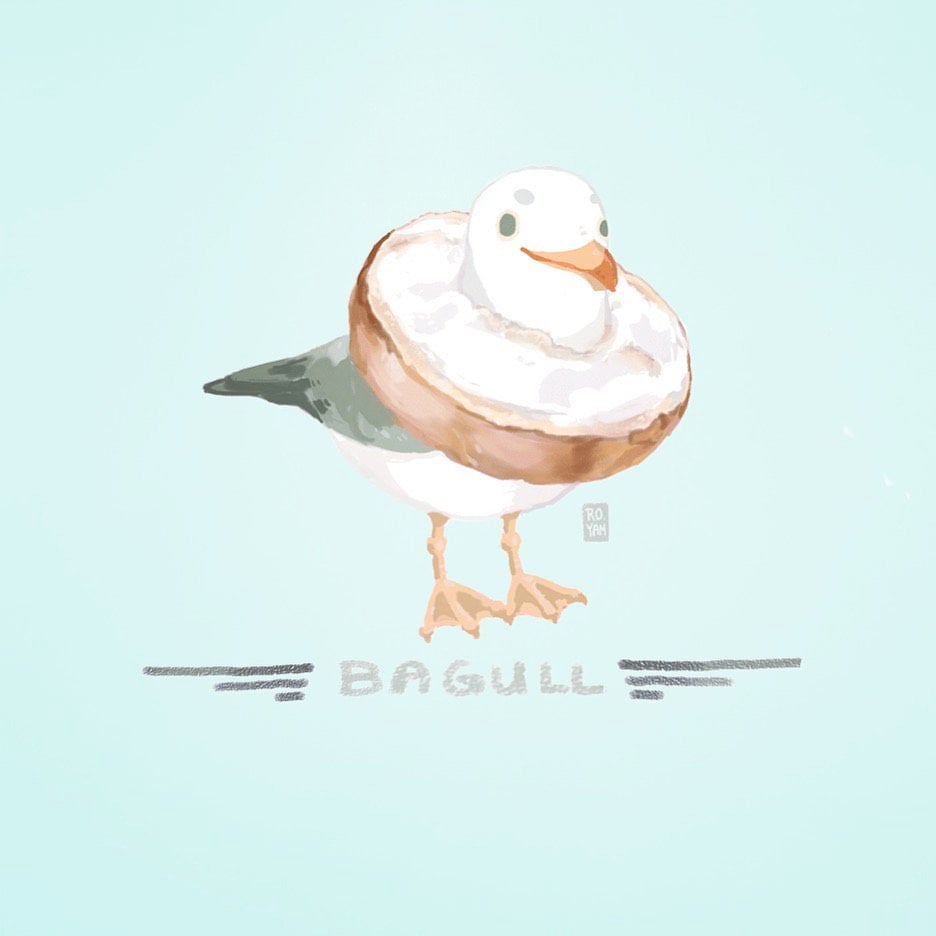
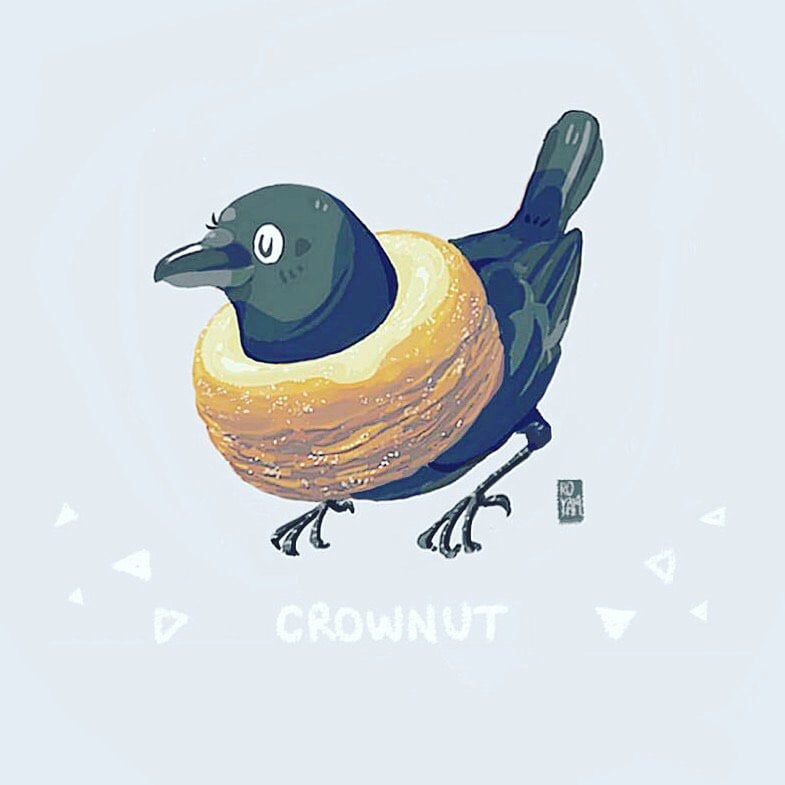

Twitter user @fuguhitman has recently done a series of bread birds with portmanteau names like Croisswant, Breadolark, Pidgingerbread, Bagull, and Crownut. Now I’m hungry and I want to go sit in a quiet forest with binoculars.
A touching Star Wars video tribute to Carrie Fisher
Next month is the 40th anniversary of the release of Star Wars and at Star Wars Celebration this year, there was a 40 Years of Star Wars panel with George Lucas, Mark Hamill, Billy Dee Williams, and Harrison Ford. At the end of the panel, after some personal thoughts from Lucas and the other panelists about Carrie Fisher, they played this video tribute to Fisher.
Should we get rid of the European Union?
As Britain lumbers towards Brexit, other parts of Europe seem to be weighing, electorally and otherwise, if the European Union is something worth keeping or whether it belongs on the trash heap of history next to The League of Nations and the Roman Empire. In this video, Kurzgesagt takes a look at some of the benefits and criticisms of the EU and considers whether the former outweigh the latter.
Nintendo is discontinuing the NES Classic! What the hell?!
Building an iPhone from scratch
Scotty Allen built a working iPhone 6S from scratch using parts bought in the electronics markets of Shenzhen, China.
I built a like-new(but really refurbished) iPhone 6S 16GB entirely from parts I bought in the public cell phone parts markets in Huaqiangbei. And it works!
I’ve been fascinated by the cell phone parts markets in Shenzhen, China for a while. I’d walked through them a bunch of times, but I still didn’t understand basic things, like how they were organized or who was buying all these parts and what they were doing with them.
So when someone mentioned they wondered if you could build a working smartphone from parts in the markets, I jumped at the chance to really dive in and understand how everything works.
It is kind of amazing that he ends up with a fully functional iPhone, complete with a box with charger, headphones, etc. The era of transistor radio kits is not quiiiite dead yet. (via bb)
Update: Allen also modified his iPhone 7 to include a dedicated headphone jack.
What will the night sky look like in 5 million years?
Based on the motions of the 2 million stars observed by ESA’s Gaia mission over the past two years, scientists created this simulated animation of how the view of the Milky Way in the night sky will evolve over the next 5 million years.
The shape of the Orion constellation can be spotted towards the right edge of the frame, just below the Galactic Plane, at the beginning of the video. As the sequence proceeds, the familiar shape of this constellation (and others) evolves into a new pattern. Two stellar clusters — groups of stars that were born together and consequently move together — can be seen towards the left edge of the frame: these are the alpha Persei (Per OB3) and Pleiades open clusters.
Stars seem to move with a wide range of velocities in this video, with stars in the Galactic Plane moving quite slow and faster ones appearing over the entire frame. This is a perspective effect: most of the stars we see in the plane are much farther from us, and thus seem to be moving slower than the nearby stars, which are visible across the entire sky.
Well, how’s that for some perspective? (via blastr)
NASA’s new nighttime map of the entire Earth
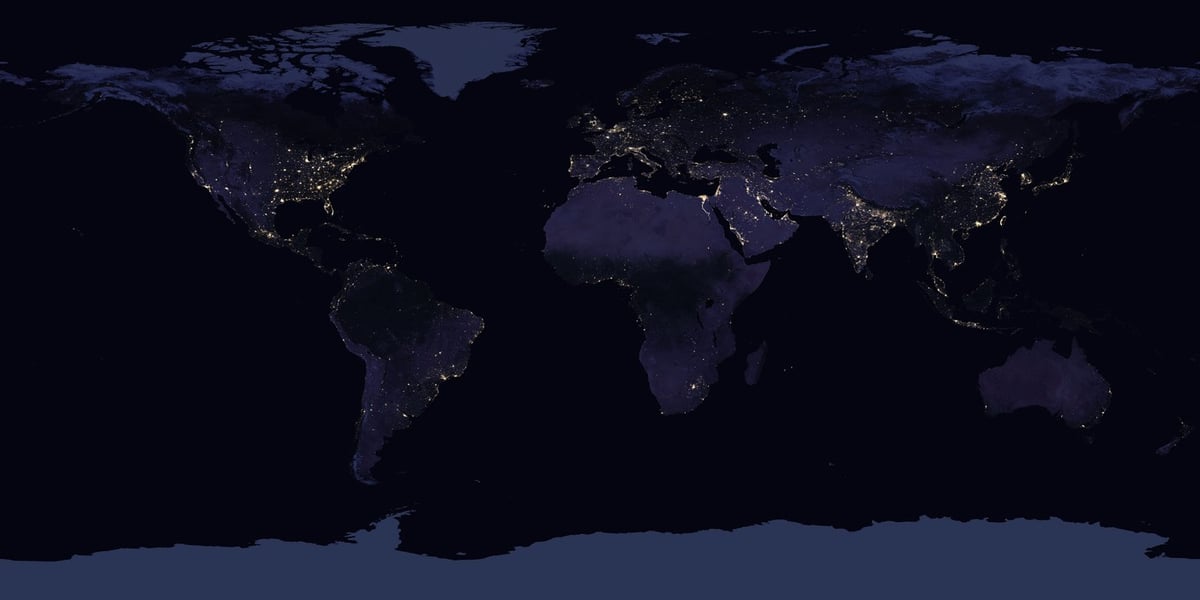

For the first time since 2012, NASA has released a new map of the entire Earth at night. Of course, you don’t see the Earth so much as the activity of humans in well-lit cities.
Today they are releasing a new global composite map of night lights as observed in 2016, as well as a revised version of the 2012 map. The NASA group has examined the different ways that light is radiated, scattered and reflected by land, atmospheric and ocean surfaces. The principal challenge in nighttime satellite imaging is accounting for the phases of the moon, which constantly varies the amount of light shining on Earth, though in predictable ways. Likewise, seasonal vegetation, clouds, aerosols, snow and ice cover, and even faint atmospheric emissions (such as airglow and auroras) change the way light is observed in different parts of the world. The new maps were produced with data from all months of each year. The team wrote code that picked the clearest night views each month, ultimately combining moonlight-free and moonlight-corrected data.
Scientists are planning on providing “daily, high-definition views of Earth at night” starting later this year. It’s worth clicking through to play with the interactive India map…it’s astounding to see how much light the country has added in the past 5 years. And see if you can spot North Korea at night:
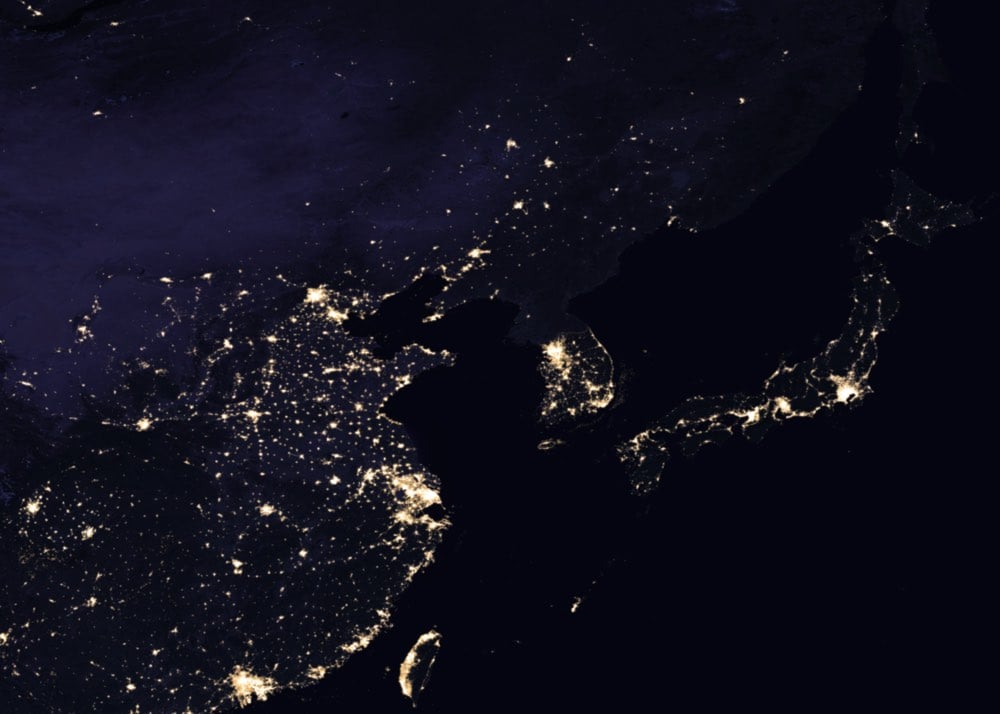
Barely…just a tiny dot for Pyongyang. You can play around with a fully zoomable version of the entire map here. (via @JamesJM)
Experiencing Grief Can Feel Like Tripping on Hallucinogens
Last year, Ariel Meadow Stallings of Offbeat Wed wrote a piece in the Guardian called Seven things I wish I’d known before my divorce: an optimistic guide to the future. It’s a good list, full of problems turned into opportunities, but the first item blew my mind a little.
1. Trip out on grief — it’s a hallucinogen.
Regardless of how your marriage ends, it’s a death. Maybe it’s a loving euthanasia that you both agree on, maybe it’s a violent one-sided decision that only one of you sees coming, but it’s a death regardless. This means both of you will go through grief — a powerful mind-altering substance.
In the darkest of my days, I felt like I was on a low dose of LSD at all times — time was weird, my vision was odd, I threw up for no reason, my emotions were out of control. Even eating was an intellectual exercise (chew, chew … swallow? Is that what you do next?). I generally felt like I was tripping.
This state of mind was profoundly uncomfortable, but also weirdly educational. Never a big crier, I received a crash course in what tear-induced catharsis felt like — and holy wow, it felt good. Like many mind-altering substances, there are lessons there if you want to learn them.
I didn’t realize it until I read this, but having experienced the sort of grief Stallings describes here and come out the other side (mostly) the better for it, I can attest to her description of it as a trippy educational experience.
Aleutian Dreams: photos of the Alaskan fishing industry
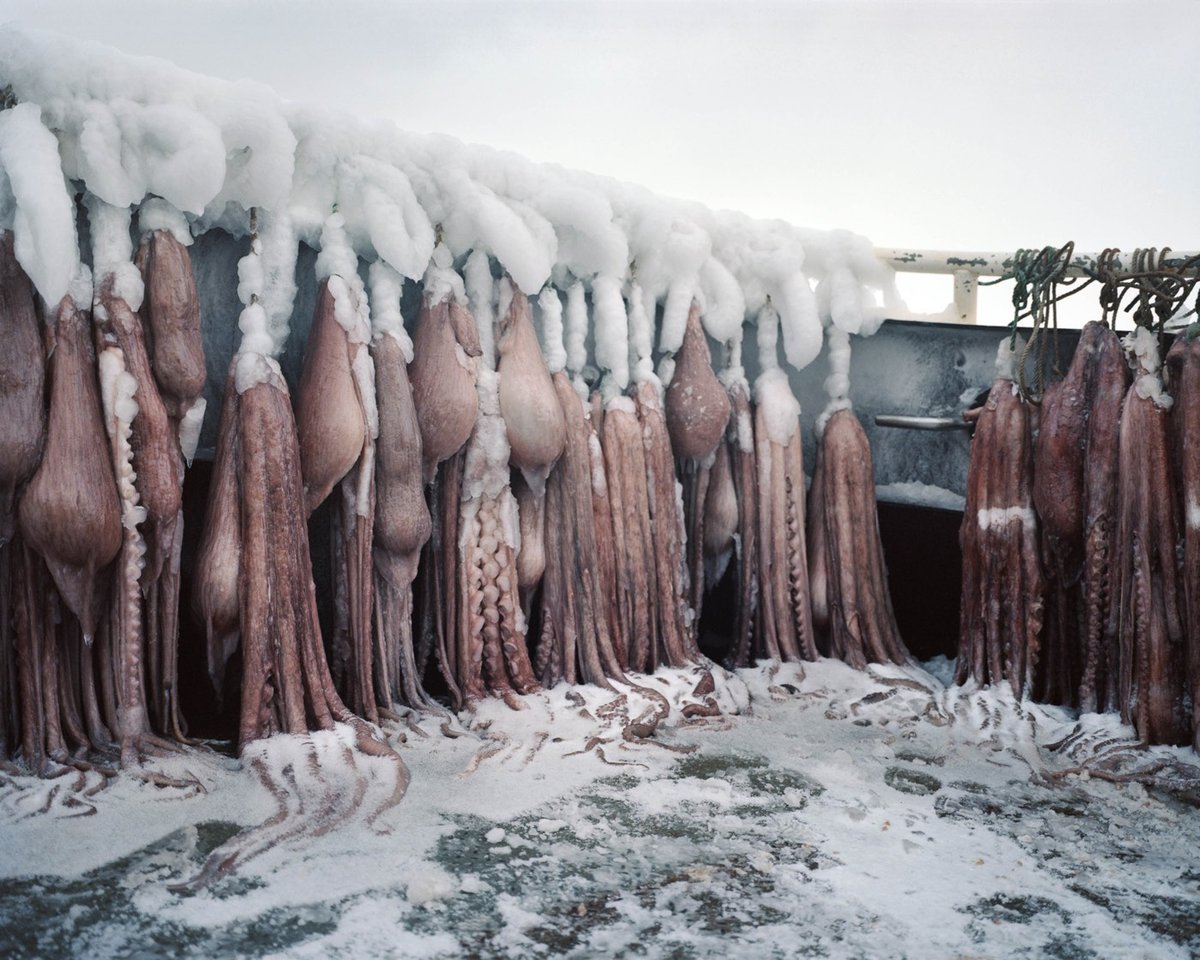
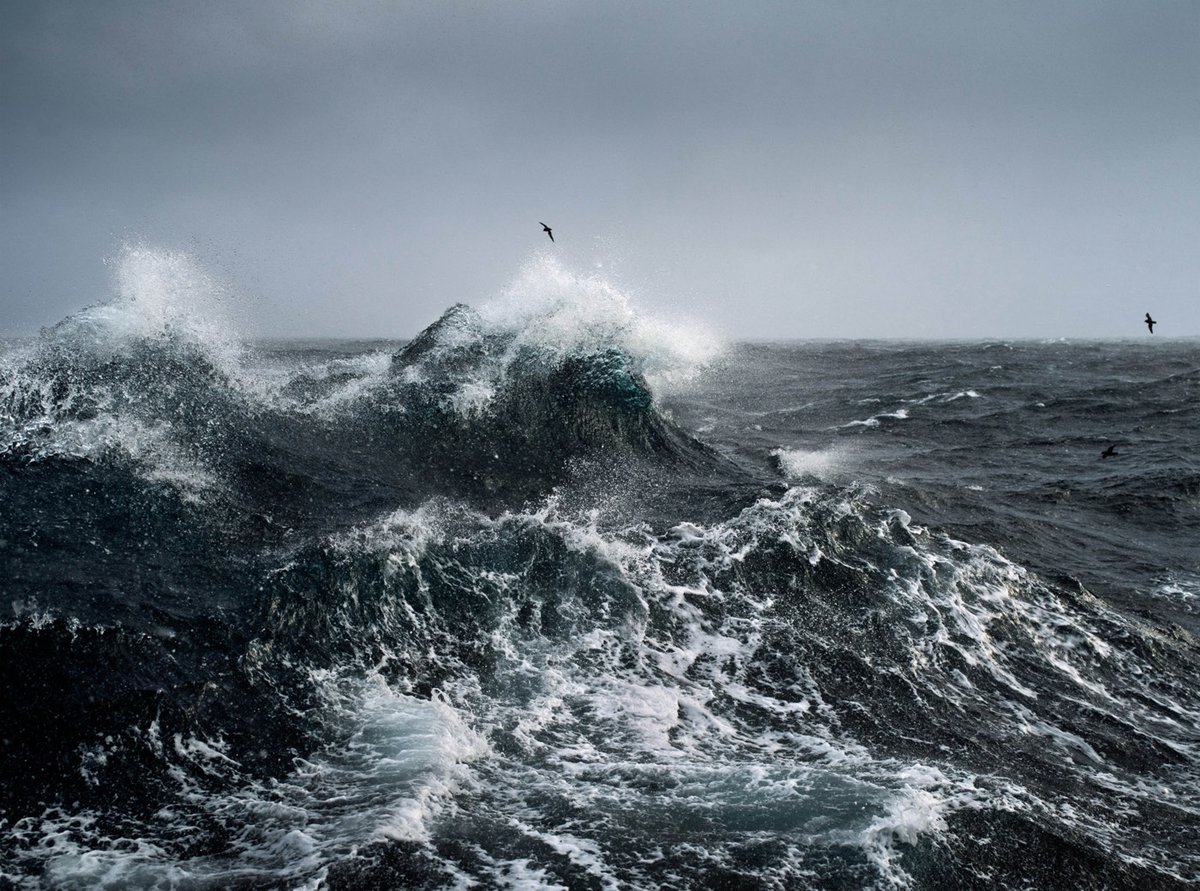
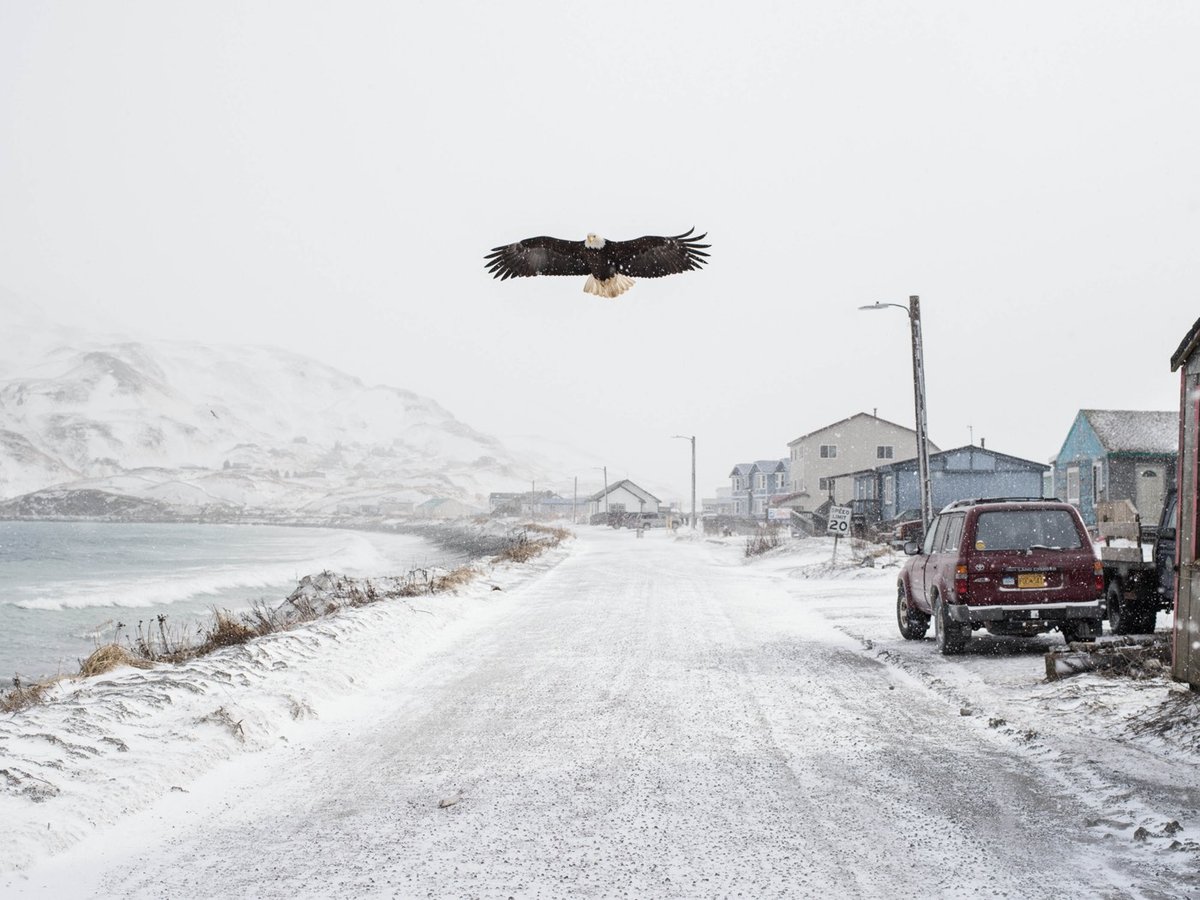
For a project called Aleutian Dreams, photographer and fisher Corey Arnold has documented the lives and landscapes of the fishing industry in Alaska’s Aleutian Islands.
Fifteen years ago, I wrote a job-wanted sign and hung it outside of a bathroom near Seattle’s Fisherman’s Terminal. It read: “Experienced deckhand looking for work on a commercial crab or halibut fishing boat in Alaska — hard worker — does not get seasick” I was 24 years old, energetic and ambitious, with a few years of salmon fishing experience but naive to the world of high seas fish-work. After a few shifty respondents, I was hired by a seasoned Norwegian fisherman and flew on a small prop plane past the icy volcanos and windswept passes of Alaska’s Aleutian Islands, eventually slamming down onto the short runway in Dutch Harbor. The experience would forever change the direction of my life and shape my identity as both a fisherman and photographer. Isolated from the mainland by some of the world’s roughest waters, Dutch Harbor is a thriving, working-class commercial fishing port surrounded by steep mountains and lonely windswept valleys. It’s a place where industry and nature collide in strange and beautiful ways, a place where people harvest seafood on a massive scale, and share their meals and their refuse with local wildlife — from rapacious bald eagles to curious foxes.
(via the guardian)
Giant meteorite sculpture is at the center of a stunning UK Holocaust Memorial proposal


British sculptor Anish Kapoor and Zaha Hadid Architects have proposed a massive sculpture resembling a meteorite for the centerpiece of the UK Holocaust Memorial.
Meteorites, mountains and stones are often at the centre of places of reflection, especially in the Jewish tradition. They call on the vastness of nature to be a witness to our humanity. A memorial to the Holocaust must be contemplative and silent, such that it evokes our empathy. It must be a promise to future generations that this terrible chapter in human history can never occur again.
All ten shortlisted proposals can be viewed on the design competition site.
On the design of windshield wipers. I’m glad someone finds stuff like this as interesting as I do.
Elegantly carved birds immersed in watercolor paint


Mexican artist Moisés Hernández makes these simple, graceful bird sculptures by having a machine carve the shapes out of ash and filling in the plumage by hand-dipping them in watercolor paint, as if decorating Easter eggs.
In an attempt of generating a balanced dialogue between machine made and handmade objects, we made soft and continuous shapes milled with CNC technology contrasted with handmade painting done by immersion in coloured water, an experimental technique we developed for this project, which gives the birds a unique personality. This technique of painting allows to achieve an interesting texture of intersections and transparency made by layers of colour that resembles the plumage of birds. The amount of colour, hue and the way sections cross one another depends on the time and position the wood is plunged.
Lovely. (via colossal)
Dylan Matthews donated a kidney to a complete stranger
Last August, Dylan Matthews donated one of his kidneys to someone he’d never met before.
On Monday, August 22, 2016, a surgical team at Johns Hopkins Hospital in Baltimore removed my left kidney. It was then drained of blood, flushed with a preservative solution, placed on ice, and flown to Cincinnati.
Surgeons in Cincinnati then transplanted the kidney into a recipient I’d never met and whose name I didn’t know; we didn’t correspond until this past month. The only thing I knew about him at the time was that he needed my kidney more than I did. It would let him avoid the physically draining experience of dialysis and possibly live an extra nine to 10 years, maybe more.
Why did he do it? Because he thought it was the right thing to do morally.
I’d wanted to give a kidney for years — at least since I first heard it was possible after reading Larissa MacFarquhar’s New Yorker piece on “good Samaritan” kidney donors when I was in college. It just seemed like such a simple and clear way to help someone else, through a procedure that’s very low-risk to me. I studied moral philosophy as an undergrad, and there’s a famous thought experiment about a man who walks by a shallow pond where a child is drowning and does nothing, because leaping in to save the child might muddy his clothes.
As Matthews notes, all you need to do to get started on the road to becoming a living donor is fill out this form.
What if Barry Bonds had played without a baseball bat?
Barry Bonds was a ridiculously good baseball player. In this installment of the highly entertaining Chart Party series, Jon Bois answers a very hypothetical question: What if, during his monster 2004 season, Bonds had gone to the plate without a bat? This is super entertaining if you’re any kind of a baseball fan and the end result is really shocking. (via @caseyjohnston)
Trailer for the latest Thor movie
For awhile, I think Hollywood forgot that movies are supposed to be fun. This looks fun, like movies in the 80s were before the studios started fixating too much on boobs and bombs for teen boys, gritty reboots, and save-the-world movies.
The stock market’s reaction to United debacle vs a school shooting
Yesterday, a video of a man dragged from an overbooked United flight because he wouldn’t give up his seat went viral. Public reaction to the incident and United’s subsequent fumbling of the aftermath has resulted in UAL’s stock falling several percentage points this morning:

The stock has rebounded slightly this afternoon and will probably fully recover within the next few weeks.
Also yesterday, a man walked into a San Bernardino elementary school and killed a teacher (his estranged wife) and an 8-year-old boy before shooting himself. The story has received very light national coverage, particularly in comparison to the United story. In response, the stock prices of gun companies were up a few percent this morning (top: American Outdoor Brands Corp which owns Smith & Wesson; bottom: Sturm, Ruger & Company):


This follows a familiar pattern of gun stock prices rising after shootings; Smith & Wesson’s stock price rose almost 9% after the mass shooting in Orlando last year.
Update: It took about three and a half weeks, but on May 2, United’s stock had regained all of the value “lost” due to the incident and subsequent PR blunders. As of this writing (May 3 at 12:41 PM ET), UAL is actually up about 3.5% from the closing price before the incident.
The stunning visual effects from Ghost in the Shell
From concept designer Ash Thorp, a reel of visual effects he worked on for Ghost in the Shell, from animation tests to completed effects featured in the film.
Early on in the film’s development, I met with Rupert to discuss some of the creative direction. He expressed his desire to paint the city with neon lights in a new form that he coined as “Solograms”, which are solid holograms. It is something in the realm of a particle system of light that can be moved and augmented in Z space. I loved the idea and instantly got to work building out concepts and ideas. Below you will see a mix of various style frames, concepts, and final production assets that made it into the film.
I saw this the other day and the effects are amazing; I wish the story could have been a little better.
Update: For more on the visual effects in Ghost in the Shell, see also this piece in Creative Review and this extensive look from Cinematography Database.
Marvelous and super-detailed visualizations of the complex structure of the human brain

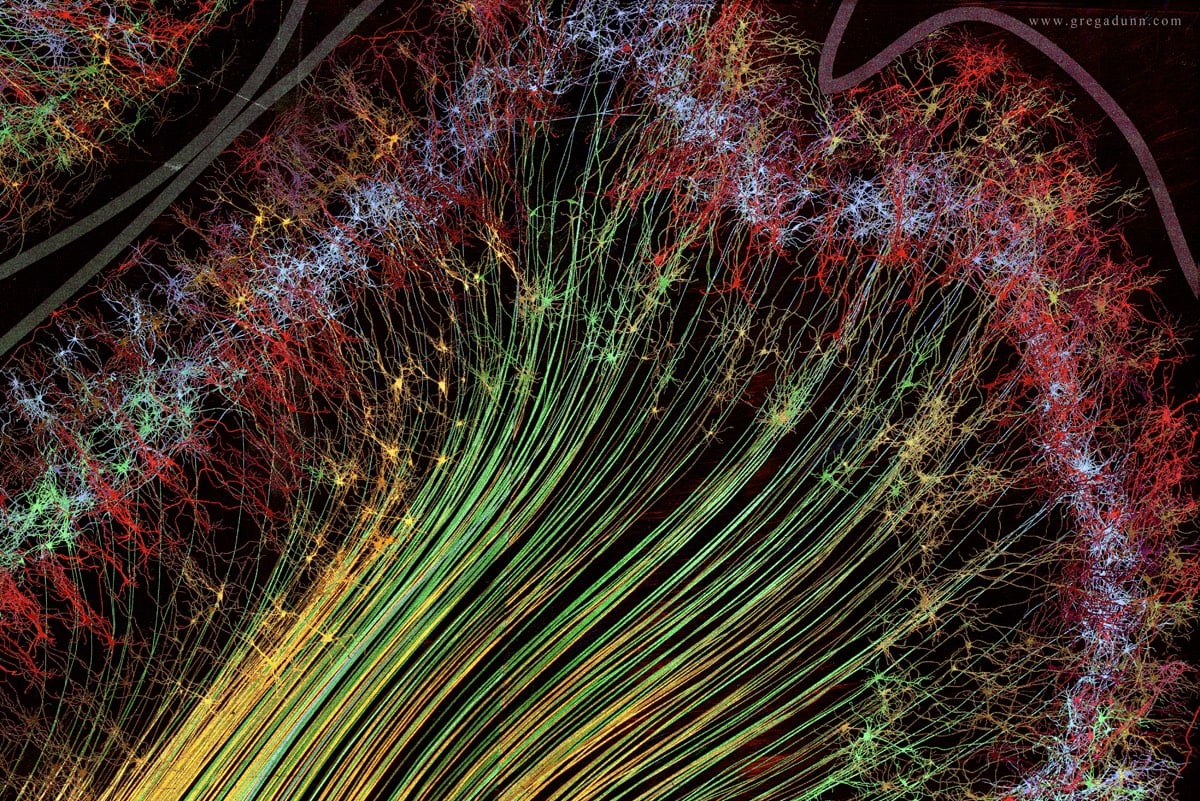
Self Reflected is a project by a pair of artist/scientists that aims to visualize the inner workings of the human brain.
Dr. Greg Dunn (artist and neuroscientist) and Dr. Brian Edwards (artist and applied physicist) created Self Reflected to elucidate the nature of human consciousness, bridging the connection between the mysterious three pound macroscopic brain and the microscopic behavior of neurons. Self Reflected offers an unprecedented insight of the brain into itself, revealing through a technique called reflective microetching the enormous scope of beautiful and delicately balanced neural choreographies designed to reflect what is occurring in our own minds as we observe this work of art. Self Reflected was created to remind us that the most marvelous machine in the known universe is at the core of our being and is the root of our shared humanity.
It’s important to emphasize that these images are not brain scans…they are artistic representations of neural pathways and other structures in the brain.
Self Reflected was designed to be a highly accurate representation of a slice of the brain and is informed by deep neuroscience research to allow it to function as a reliable educational tool as well as a work of art.
Kubrick’s original ending of The Shining
When The Shining premiered in 1980 in NYC and LA, there was a short scene in a hospital between the shot of Jack Torrence frozen in the maze and the long zoomed-in shot of the framed photo. After the premieres, director Stanley Kubrick decided the scene didn’t work and had it cut from dozens of prints and destroyed.
It’s also important to note that this was likely not the exact scene that Kubrick shot; since the scene no longer exists, it’s impossible to know how exactly it played. Even the many people who saw the epilogue when The Shining was first released have varying recollections of the exact details. Clearly, the final text about the Overlook’s history was an idea omitted during the writing process.
No known copy of the scene remains but you can read it in the screenplay and see brief glimpses in these Polaroids.
The endless circular airport runway
Aviation expert Henk Hesselink thinks that airports should have circular runways instead of straight ones. Among other things, large circular runways could reduce the need for crosswind landings, use airport land more efficiently, and increase the number of planes simultaneously landing and taking off.
As part of these efforts, NLR has been involved in a European project called ‘The Endless Runway’. This radical new airport concept is based on the construction of a circular runway with a diameter of approx. 3.5 km around an airport terminal. Such an airport would take up only a third of the space of a conventional airport. Another advantage is that aircraft would always be able to take off and land independently of the wind direction, since there is always a point without crosswind on the circular runway. Landing aircraft can also be routed away from residential areas because they are not dependent on a standard approach path. Finally, the ‘Endless Runway’ concept will enable multiple aircraft to take off and land simultaneously, resulting in increased airport capacity.
According to Hesselink’s research, a circular runway as long as three normal runways (and the diameter of one runway) could handle the traffic of four normal runways. (thx, dad)
Climate change is shifting cherry blossom peak-bloom times
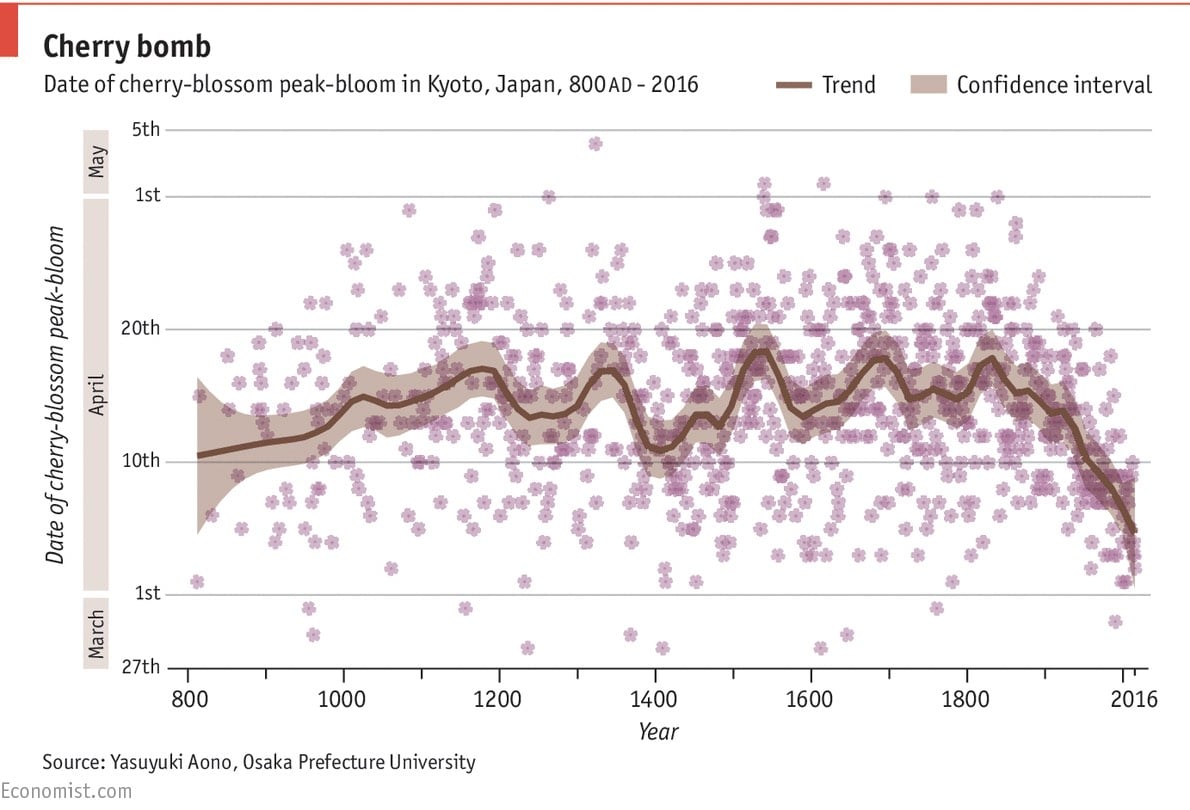
Records of when the cherry blossoms appear in Kyoto date back 1200 years. (Let’s boggle at this fact for a sec…) But as this chart of peak-bloom dates shows, since the most recent peak in 1829, the cherry blossoms have been arriving earlier and earlier in the year.
From its most recent peak in 1829, when full bloom could be expected to come on April 18th, the typical full-flowering date has drifted earlier and earlier. Since 1970, it has usually landed on April 7th. The cause is little mystery. In deciding when to show their shoots, cherry trees rely on temperatures in February and March. Yasuyuki Aono and Keiko Kazui, two Japanese scientists, have demonstrated that the full-blossom date for Kyoto’s cherry trees can predict March temperatures to within 0.1°C. A warmer planet makes for warmer Marches.
Temperature and carbon-related charts like this one are clear portraits of the Industrial Revolution, right up there with oil paintings of the time. I also enjoyed the correction at the bottom of the piece:
An earlier version of this chart depicted cherry blossoms with six petals rather than five. This has been amended. Forgive us this botanical sin.
Gotta remember that flower petals are very often numbered according to the Fibonacci sequence.
Coming up short in pursuit of a SuperBaby
In SuperBabies Don’t Cry, Heather Kirn Lanier writes beautifully about the birth of her first daughter, disability, control, and acceptance.
By eight months Fiona developed a love for clapping. At nine months she had her first grand mal seizure. At eleven months she rolled from front to back. At one year old she weighed twelve pounds. During that first year, her syndrome revealed itself to be simultaneously life-altering and, in some strange way, just fine. A new normal. Her medical issues were manageable. The problem, it became clear, was mine: I wanted her different. The daily prayer inside me was an impossible wish to scrounge the earth and find that missing bit of her fourth chromosome. I imagined it was buried among fossils in an ancient, surreal sand dune.
Ten times this piece sent my thoughts spiraling out in all directions. I already know I’m gonna be thinking about this all week. (via @ftrain)
Musical fractals
Adam Neely made a song that is constructed of smaller versions of itself, resulting in a musical fractal that sounds the same at full speed and at 1000 times slower. How does it work? Harmonic polyrhythms.
E=mc^2 tells us that mass and energy are the same thing, just on massively different scales. This is similar to the musician’s theory of relativity which says that rhythm, melody, and harmony are the same thing, just on similarly massively different scales.
So by slowing things way down or speeding things way up, you can convert between harmony and rhythm. (via waxy)
Incredible low-light camera turns night into day
The X27 camera takes videos in darkness that looks like they were shot in the daytime. And they’re in color…none of this black and white, thermal, or infrared stuff. The camera was developed for military use, has an effective ISO rating of 5,000,000, and has a comically long name: “X27 Reconnaissance Day/Night high Fidelity true real time low light/low lux color night vision Imaging Security / Multi Purpose camera system”. Pricing information is not available, but I bet you’re paying for every single one of those words. (via digg)
The Crowdsourceress, a book by Alex Daly with advice on how to run successful crowdfunding campaigns
Translating Music Into American Sign Language
Amber Galloway Gallego is a ASL interpreter who has developed new techniques and expressions to translate popular music into a richer experience for deaf and hard-of-hearing people than just simply translating the lyrics.
If you frequent music festivals and concerts, you might see her — or an interpreter like her — grooving to the music, mirroring the emotions and physicality of the artists onstage, interpreting their imaginative lyrics for concert-goers who rely on visual accommodations. She’s interpreted for more than 400 artists at this point, and has a special knack for interpreting hip-hop acts.
Part of the challenge here, particularly with fast-moving rap or hip hop, is combine or abbreviate signs in order to keep time with the lyrics. See Shelby Mitchusson performing Eminem’s Lose Yourself or Gallego doing a faster song of his, Rap God:
A dialect coach demonstrates 12 different accents
Sammi Grant is a dialect coach and voiceover artist for television and theater. In this video, she demonstrates her expertise in speaking English with several different accents, including Irish, Scottish, German, the American midwestern accent, and the Transatlantic accent, an accent invented to sound both American and British simultaneously.
No, really. That’s not a real accent. It’s a now-abandoned affectation from the period that saw the rise of matinee idols and Hitchcock’s blonde bombshells. Talk like that today and be the butt of jokes (see Frasier). But in the ’30s and ’40s, there are almost no films in which the characters don’t speak with this faux-British elocution-a hybrid of Britain’s Received Pronunciation and standard American English as it exists today. It’s called Mid-Atlantic English (not to be confused with local accents of the Eastern seaboard), a name that describes a birthplace halfway between Britain and America. Learned in aristocratic finishing schools or taught for use in theater to the Bergmans and Hepburns who were carefully groomed in the studio system, it was class for the masses, doled out through motion pictures.
This short video has some more examples of the Transatlantic (or Mid-Atlantic) accent:
A Llama in Times Square
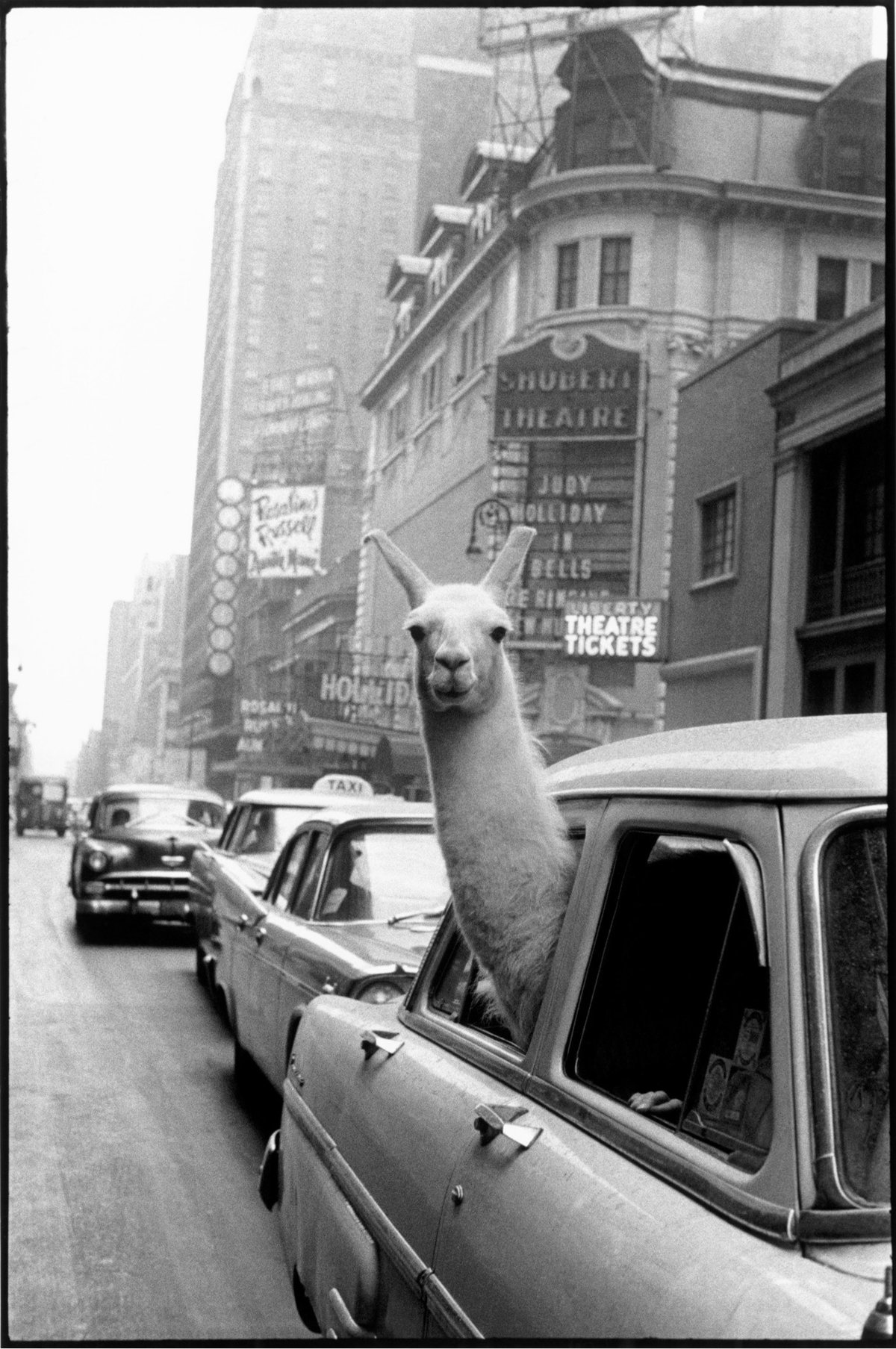
That’s Linda the Llama, photographed by Inge Morath for Life magazine. I have seen this photo many times in various contexts, but until today, I’d never really stopped to ask who photographed it or how a llama came to be riding through Times Square in a car. Perhaps it’s the context of the location, but it looks almost like something a tourist would have snapped…until further inspection reveals the perfect composition of a great photographer at work.
The caption read the llama was enroute to make a television appearance, but Morath recalled differently in her notes: “Linda, the Lama [sic] rides home via Broadway. She is just coming home from a television show in New York’s A.B.C. studios and now takes a relaxed and long-necked look at the lights of one of the world’s most famous streets.” Her contact sheets showed that Morath was already photographing the llama inside the studio, and the Inge Morath Foundation suggests the photographer might have acquainted herself with the llama and the trainer at least a year ahead of their photo-session.
Morath was a member of Magnum Photos, joining the collective a few years after its inception. She initially joined as an editor and researcher but after taking up photography herself and assisting Henri Cartier-Bresson, she became a full member as a photographer in 1955.
I think that in studying [Cartier-Bresson’s] way of photographing I learned how to photograph myself, before I ever took a camera into my hand. […] It was instantly clear to me that from now on I would be a photographer. As I continued to photograph I became quite joyous. I knew that I could express the things I wanted to say by giving them form through my eyes.
I love this story about Morath from her Wikipedia profile (originally from a piece in Time):
In 1959, while photographing the making of The Unforgiven, starring Audrey Hepburn, Burt Lancaster, and Audie Murphy, Morath accompanied Huston and his friends duck hunting on a mountain lake outside Durango, Mexico. Photographing the excursion, Morath saw through her telephoto lens that Murphy and his companion had capsized their boat 350 feet from shore. She could see that Murphy, stunned, was nearly drowning. A skilled swimmer, Morath stripped to her underwear and hauled the two men ashore by her bra strap while the hunt continued uninterrupted.
A poster of A Llama in Times Square is available for sale on Magnum’s website.
Watch As a Master Woodworker Turns a Giant Log into an Elegant Dugout Canoe
Rihards Vidzickis is a Latvian master woodworker (and materials scientist) who specializes in making dugout canoes and other rustic works out of wood. In this beautifully shot short film, Vidzickis crafts a dugout canoe from scratch over a period of a few months, using only hand tools. I’ve never considered “elegant” a word that could be associated with a dugout canoe, but here we are.
The video is long (18 min) and you’ll be tempted to skip ahead, but watching it is almost meditative and there are little woodworking tricks throughout that are really clever (like using wooden pegs for depth-finding while hollowing the canoe out). The film also provides ample evidence of the old adage “measure ten times, cut once” (or something like that).
Gender inequality and the Supreme Court
Tonja Jacobi and Dylan Schweers have published the results of a study they’ve done related to the role of gender in the workings of the Supreme Court. They found that female justices are interrupted much more often by male justices and advocates than male justices are.
Our empirical study examines interruptions among justices, and between the justices and the advocates, during Supreme Court oral arguments. It shows that women still do not have an equal opportunity to be heard on the highest court in the land. In fact, as more women join the court, the reaction of the male justices and the male advocates has been to increase their interruptions of the female justices.
Even in the most powerful courtroom in the world, the women are being verbally dominated.
Even without adjusting for the low representation of women, the effect is stark. On average, women constituted 22 percent of the court, yet 52 percent of interruptions were directed at them. Overwhelmingly, it was men doing the interrupting: Women interrupted only 15 percent of the time and men interrupted 85 percent of the time, more than their 78 percent representation on the court.
Their study shows that seniority can’t explain this effect — “gender is approximately 30 times more influential than seniority” — but some of it can be explained in terms of political ideology: conservative justices interrupt more than liberal justices do.
We found that the power dynamic does not only affect women: In a court that has been dominated by Republican appointees for over half a century, conservative justices have also dominated liberal justices by interrupting them. We expected cross-ideological interruptions to occur more often than interruptions within ideological camps, and this is true: 62 percent of interruptions cross ideological lines, compared to 38 percent within an ideological camp. However, the effect does not go in both directions: 70 percent of interruptions were of liberals, and only 30 percent of conservatives. Once again, advocates display the same tendency. Advocates interrupting the liberal justices account for over ten percent of interruptions, yet advocate interruptions of the conservative justices account for less than three percent of interruptions.
I wonder what the results would look like if Clarence Thomas ever talked in court? (via @caitlin__kelly)
The Double King
The Double King takes “thou shalt not have any other kings before me” very seriously. (via @tonyszhou)
An average hand-drawn map of the world
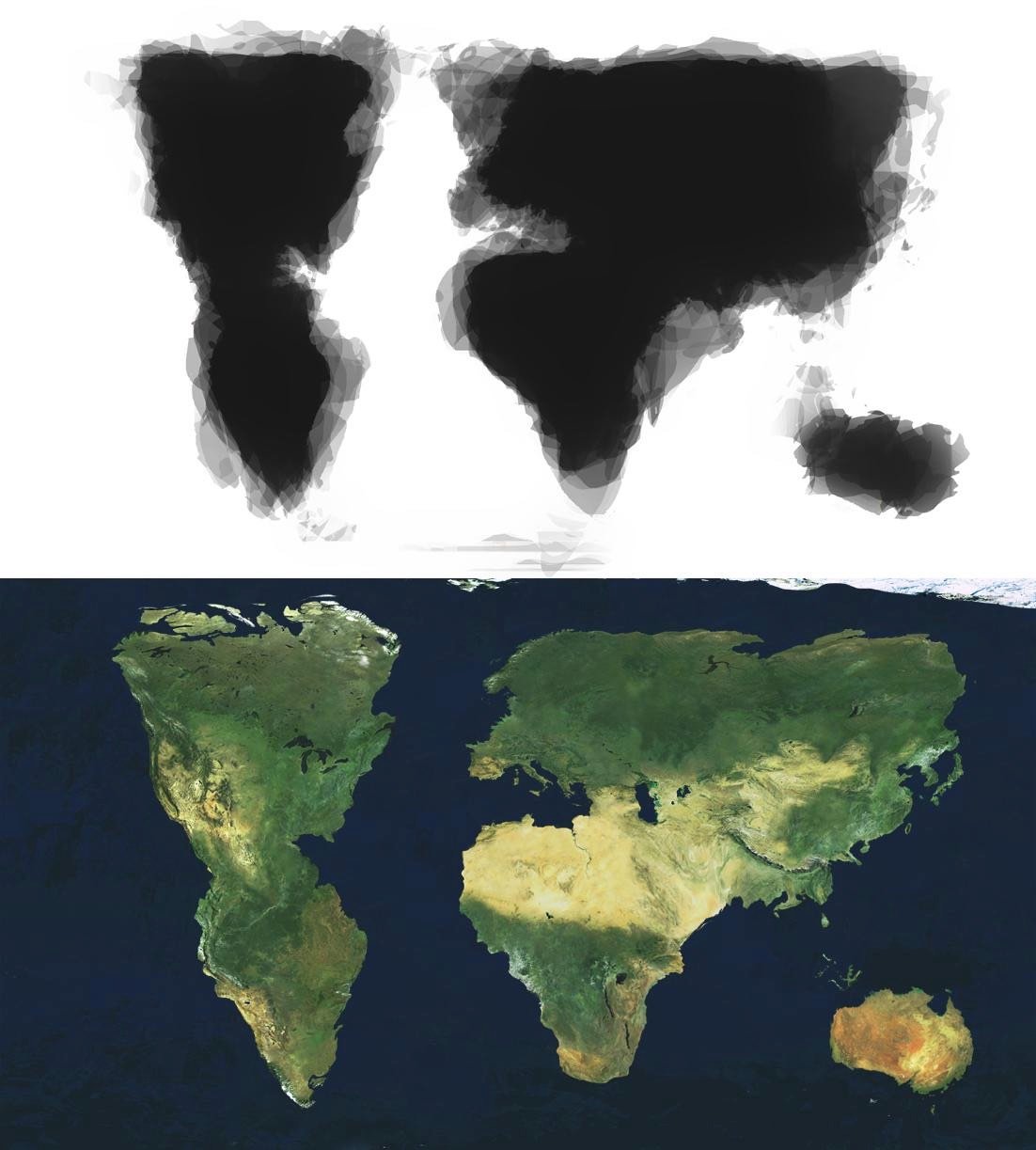
Zak Ziebell asked 30 people to sketch a map of the world and then averaged the results into the map above. I especially love the bottom one with the satellite terrain.
Tasked with creating “a piece of art that would reveal something unseen” as part of a pre-college fine arts program, Ziebell approached 29 strangers on the University of Michigan’s campus, handed them a pen and half a sheet of paper, and asked them, on the spot, to draw a map of the world. Ziebell, who recently posted his findings to Reddit, then completed the task himself and digitally merged the 30 maps into one image, overlaying the composite drawing with satellite data.
Update: This is yet another world map without New Zealand. (via @edmz)
The NYPD’s Doppelganger Problem and Racially Unfair Policing
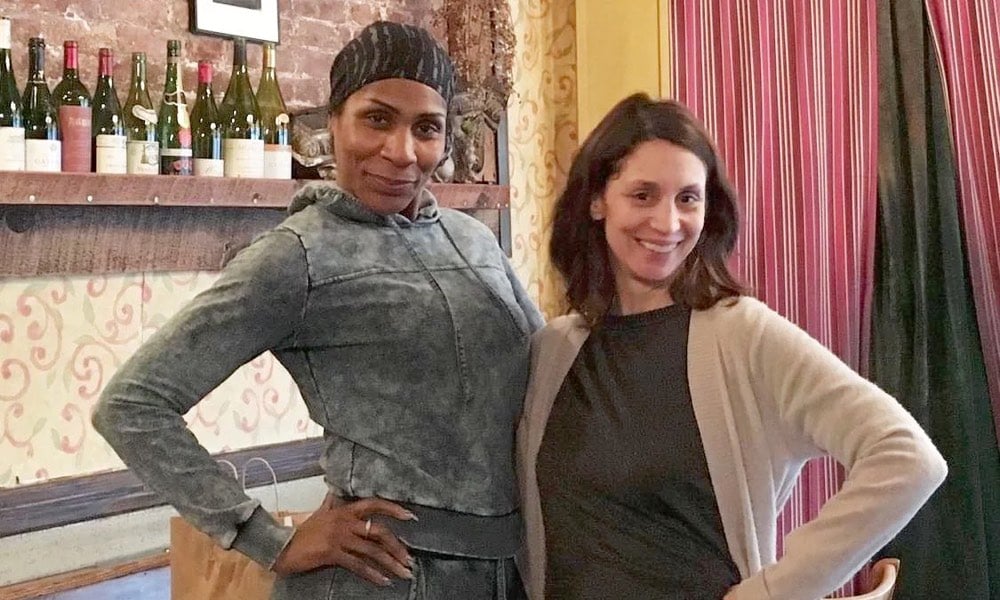
For years, a white woman named Lisa Davis was paying the price (sometimes literally) for tickets issued to other women named Lisa Davis living in NYC.
Finally, the DMV told me that I wasn’t the victim of identity theft; there was simply another Lisa S Davis with the same birthday in New York City. Our records were crossed. When cops run a license, they don’t check the person’s address, signature, or social security numbers. They check the name and the birthday, and both the other Lisa S Davis’s and mine were the same. We were, in the eyes of the law, one person, caught in a perfect storm of DMV and NYPD idiocy.
In fighting all of these improperly filed tickets, Davis learned that most of them issued for bullshit “broken windows” misdemeanors in predominately minority neighborhoods.
It was then that it became clear to me: the reason for the tickets wasn’t that these Lisa Davises were petty criminals. The reason was likely that they lived in highly policed areas where even the smallest infractions are ticketed, the sites of “Broken Windows” policing. The reason, I thought, was that they weren’t white.
That could have been the “proof” I offered to the judge. Brownsville’s population is less than 1% white. It almost couldn’t have been me. My neighborhood, though fairly diverse (and cheap) when I moved there in the early 90s, is now 76% white. I have never heard of anyone getting tickets in my neighborhood for any of the infractions committed by the Lisa Davises in neighborhoods of color.
I felt there was only one thing to do. I had to find the Lisa Davises, to untangle myself from them, to talk to them about being Lisa Davises, and to see if they agreed with my supposition: that the real “crime” they had committed was being non-white.
See also Pro Publica’s report published today, Minority Neighborhoods Pay Higher Car Insurance Premiums Than White Areas With the Same Risk.
A Talented Pufferfish Creates an Underwater “Crop Circle”
The elaborate courtship rituals of animals from around the world are featured heavily in every BBC nature documentary series. (See, for instance, these birds of paradise…if you haven’t seen this before, wait for the giant clicking smile.) In the video above featuring a scene from the 2014 series Life Story, watch a Japanese puffer fish create an elaborate pattern in the sand in order to attract a mate. Narrator David Attenborough calls the puffer fish “probably nature’s greatest artist” and I gasped at the full reveal of his creation.
The internet is photoshopping Mr. Bean into things and it’s great
Sometimes when the world is crashing down around you, only the dumbest possible thing will do and today’s installment is Mr. Bean photoshopped into various things and I am loving it.

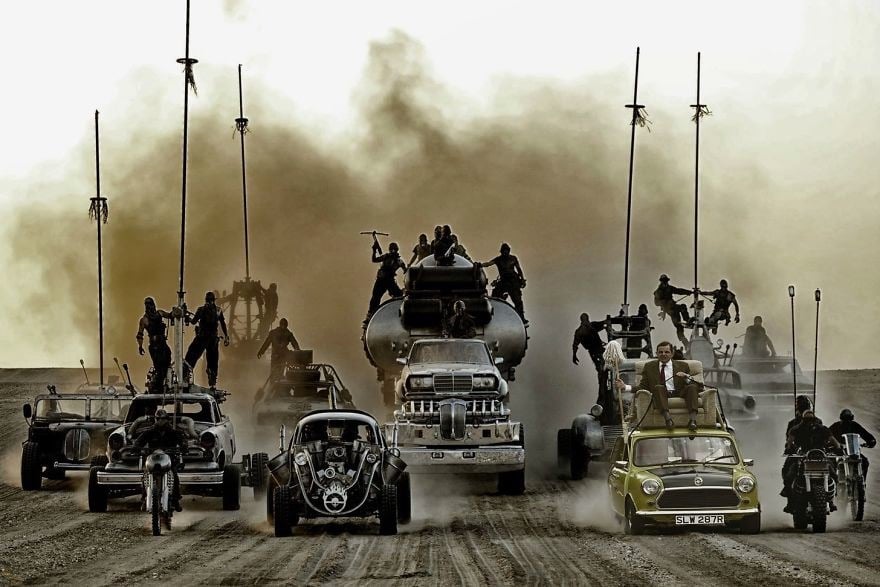

An Inconvenient Sequel
In 2006, Davis Guggenheim directed An Inconvenient Truth, a documentary film about Al Gore’s fight to educate the world about climate change. It made nearly $50 million at the box office, won the Oscar for Best Documentary Feature, and is credited for moving the conversation about climate change along (although not nearly fast enough, in my mind). This July, a followup documentary will be released: An Inconvenient Sequel: Truth to Power. From a review in the LA Times:
Eleven Sundances later, Gore’s star wattage seemed entirely undimmed at Thursday evening’s premiere of “An Inconvenient Sequel: Truth to Power,” an awkwardly titled, stirringly crafted follow-up that measures the progress that has and hasn’t been made in the battle against global warming. Taking over for Davis Guggenheim, the directors Bonni Cohen and Jon Shenk largely abandon the framing device of Gore’s lecture (which he and his international team of trainees continue to give regularly) in favor of a nimbler, more on-the-go approach.
Despite some updates on the continuing decline of the world’s glaciers and the link between climate change and the recent Zika virus outbreak, the focus this time is less on science than on politicking. Cohen and Shenk tag along with Gore on a globe-trotting mission to persuade various heads of state to invest in wind and solar energy, and reduce their reliance on fossil fuels — an effort that culminates on-screen with the signing of last year’s historic Paris climate accord.
A guide to what teens think is cool

Google recently released a report about what US teenagers think is cool. The chart above is getting a bunch of attention on social media; teens aged 13-17 were asked to rank a bunch of brands according to how cool they think they are. Since the poll was commissioned by Google (and the results published by an internal marketing team), it’s unsurprising that three Google brands (YouTube, Google, Chrome) are in the top 10. Other interesting data points:
- Teens don’t know what Zara and Uniqlo are. Or Supreme.
- Buzzfeed is only slightly cooler than Ford and Chevrolet, which are both cooler than HBO. Perhaps because HBO can’t get you to a party and you can’t make out in a Buzzfeed?
- Kraft is cooler than Red Bull.
- Whatsapp, TMZ, Vice, and Yahoo are all super uncool.
- Twitter is cooler than Facebook, but Snapchat is much cooler than both.
- The Wall Street Journal is the least cool thing in the teen universe.
- This tweet is a good reminder not to take any of this too seriously.
There’s also this curious sentence in the introduction about Generation Z:
Unlike millennials, this group is ambitious, engaged, and feel like they can change the world.
Ouch. In what universe is that even a remotely true or fair statement?
Some things I’ve read, seen, and heard in the past few months
Don’t pay too much attention to the letter grades, they’re super subjective. Oh, and don’t pay too much attention to the descriptions…also subjective. You know what, you should probably just skip this post and watch Planet Earth II instead. It’s objectively great.
The Handmaiden. Khoi Vinh turned me onto this. Loved it. (A)
What Happened, Miss Simone? Nina Simone is underrated. There are some spine-tingling live musical moments in this film. (B+)
The Three-Body Problem. Recommended by Barry. The first book is great, the next two are good but pretty depressing. (B+)
Moonlight. While this didn’t grab me as much as it did everyone else, the Academy got it right. (A-)
The Night Manager. I can see what Taylor Swift saw in Tom Hiddleston. (B+)
T2 Trainspotting. If you saw and loved the original, you should see this. It is somehow nostalgic and also not. (B)
Girls. The struggles of 20-something New Yorkers and the crises of 40-something males may not be the same, but they sure do rhyme. (B+)
Beauty and the Beast. Better than I expected, even for a musical about the Stockholm syndrome. (I mean, why didn’t the Beast let Belle go like waaaay sooner?) I never saw the original when I was a kid but somehow knew all the songs anyway? I even got a little teary at the end but perhaps that’s just because my emotional life is a puddly mess rn. (B)
Hidden Figures. Really liked this. (A-)
Turing’s Cathedral. Raging Bull. Manchester by the Sea. I am increasingly bored by stories about white dudes. Look at the rest of this list. The best stuff, the things I liked the most, are stories about or stories told by women or people of color or non-Americans. (C)
Homo Deus. Still haven’t finished this, but I’m persisting because Sapiens was so good. Hard to escape the conclusion that the sequel is not quite so good. (B-)
Planet Earth II. This is the best thing I’ve seen in the last year. Just fucking watch it already. (A+)
More Life. Liking this more than Views. Drake’s non-albums are better than his albums. (B+)
Mad Men. My second time through. Better than I remember and I remember it being great. (A+)
The Crown. Expected Downton (soapy but fun) but was rewarded with great acting and writing. Claire Foy as Elizabeth and John Lithgow as Churchill were *kisses fingers*. (A)
“Awaken My Love”. I’m sorry, I just couldn’t figure this one out. (C-)
Wonderland. Steven Johnson’s best book yet. (A)
The Underground Railroad. Nothing to say about this that already hasn’t been said. (A)
Logan. Producers are realizing they’ve stocked their superhero movies with great actors so maybe they should give them material worthy of their talents. (B+)
Finding Dory. It’s a movie about disability. (A-)
Abstract. Pretty good, but I agree with Rob Walker’s take. Niemann is closest to the way I work/think but I liked Bjarke’s episode the best…even though I’ve got some, er, issues with the guy. (B)
Harry Potter and the Cursed Child. The script, not the play. I have now read all 8 of the Harry Potter books with my kids…it took more than 4 years. Very sad it’s over…it ended up being one of the most rewarding things I’ve done with them. (B+)
Getting Apple scoops with this one weird blog
John Gruber has good news for hardcore Mac users: Apple is releasing a completely redesigned Mac Pro next year and new iMacs with pro-level specs this year. Intriguing, but I’m more interested in how this news was delivered:
There are only nine people at the table. Phil Schiller, Craig Federighi, and John Ternus (vice president, hardware engineering — in charge of Mac hardware) are there to speak for Apple. Bill Evans from Apple PR is there to set the ground rules and run the clock. (We had 90 minutes.) The other five are writers who were invited for what was billed as “a small roundtable discussion about the Mac”: Matthew Panzarino, Lance Ulanoff, Ina Fried, John Paczkowski, and yours truly.
Gruber runs a one-person independent blog that he started as a hobby and now he’s one of five people on the planet that the largest company in the world invites in for an unprecedented preview of new Mac hardware. (And I would argue he’s perhaps the only one invited who would be viewed as indispensable — you could see the others swapped out for Mossberg or Pogue or Swisher or Manjoo, but not Gruber.) That’s incredible and inspiring. It may be the twilight of the independent blogger, but Gruber continues to show how a small-but-obsessive site can do things no one else can.
Update: A pal just alerted me that Daring Fireball is having difficulty serving pages, something that usually only happens to sites DF features. “Is this the first self-fireballing in Gruber’s history?” (via @djacobs)
The Orion Nebula, our friendly neighborhood star factory

Rolf Olsen recently took this amazing photo of the Orion Nebula using a home-built telescope.
The Orion Nebula is one of the most studied objects in the sky and also has a significant place in the history of astrophotography. In 1880 it was the first ever nebula to be photographed; Henry Draper used the newly invented dry plate process to acquire a 51-minute exposure of the nebula with an 11 inch telescope. Subsequently, in 1883, amateur astronomer Andrew Ainslie Common recorded several exposures up to 60 minutes long with a much larger 36-inch telescope, and showed for the first time that photography could reveal stars and details fainter than those visible to the human eye.
Thanks to Phil Plait for the link…he’s got much more to say about the image and the nebula here.
Also called M42 (the 42nd object in a catalog kept by comet hunter Charles Messier in the late 18th century), it is a sprawling star factory, a gas cloud where stars are born. It’s a couple of dozen light-years across, and sits well over a thousand light-years from Earth. That’s 10,000 trillion kilometers, and you can see it with your naked eye! It’s so bright because of a handful of extremely massive hot stars sit in its center. They blast out ultraviolet light that energizes the gas in the nebula, causing it to glow.
It’s actually a small section of a much larger dark cloud, what’s called a molecular cloud, that we cannot see directly. Stars were born near the edge of that cloud, not too deeply inside it, and when they switched on their fierce light and stellar winds blew a hole in the cloud, popping it like a bubble. The Orion Nebula is a cavity in the side of that cloud, carved by the newborn stars.
Some site news: a (temporary) farewell to advertising
For the past 12 years, working on kottke.org has been my full-time job. For all but two of those years, my primary source of income has come from a small advertisement that appeared on each page of the site served up by The Deck. The Deck was small advertising network that displayed ads on sites like kottke.org, Daring Fireball, swissmiss, MetaFilter, and The Morning News from advertisers like MailChimp, Slack, Adobe, Amazon, Microsoft, Facebook, etc. etc. etc. The ads were small & clean and accompanied by a bit of text and a link; that’s it. No tracking, no targeting, no pop-ups. The ads were tasteful, polite even. In exchange for allowing these companies a small piece of my site to tell you folks about their products and services, I was paid a fixed amount every month, direct-deposited like clockwork into my bank account. I never ever had to think about it — we didn’t even have a contract!1 — all I had to do was write. All in all, a fair trade for everyone involved.
Sharp-eyed readers will note that The Deck ad is no longer on the site. Some months ago, Jim Coudal informed me that the ad network was struggling to attract advertisers. An attempt at restructuring failed and, as of March 31, The Deck is no more. There’s much I could say about the challenges faced by small independent sites now and how drastically the online advertising market has changed in the past few years, but mostly I’d like to thank Jim (and original Deck co-conspirators Jason Fried and Jeffrey Zeldman) for building a service that allowed me do my thing with minimal fuss for so long. Jim, I wish you continued good luck in steering the Field Notes juggernaut.
So, where does that leave kottke.org? Luckily I anticipated something like this happening1 and the launch of memberships back in November has left the site on stable financial ground, even without advertising. Thank you, members! Seriously, you people saved the Building & Loan. And if you’re not yet a member and you find value in what I do here, there has never been a better time to support kottke.org.
Even so, in the interests of necessarily diversifying the revenue of this here very small business, I will be looking at options for replacing The Deck with….something. I have a few leads and ideas but am open to suggestions. Wanna do a year-long sponsorship of one of the best independent sites on the internet? Got a line on a small ad network with tasteful advertising? Do you have experience with online advertising and advice for me? Let’s talk. Chumbox providers need not apply.
You would not believe the looks people gave me when I told them this. My entire livelihood, dependent on a handshake! I dunno, it just never seemed necessary. *shrug* ↩
Which I feel a little clever about except that I should have done the membership thing years ago. Idiot. Just as every problem is actually a opportunity, every success is an chance to consider how you might have done it better.↩
A collection of all the paintings by Bob Ross and the tools/colors you’ll need to paint along w/ him
Misty black & white watercolor paintings of animals and children
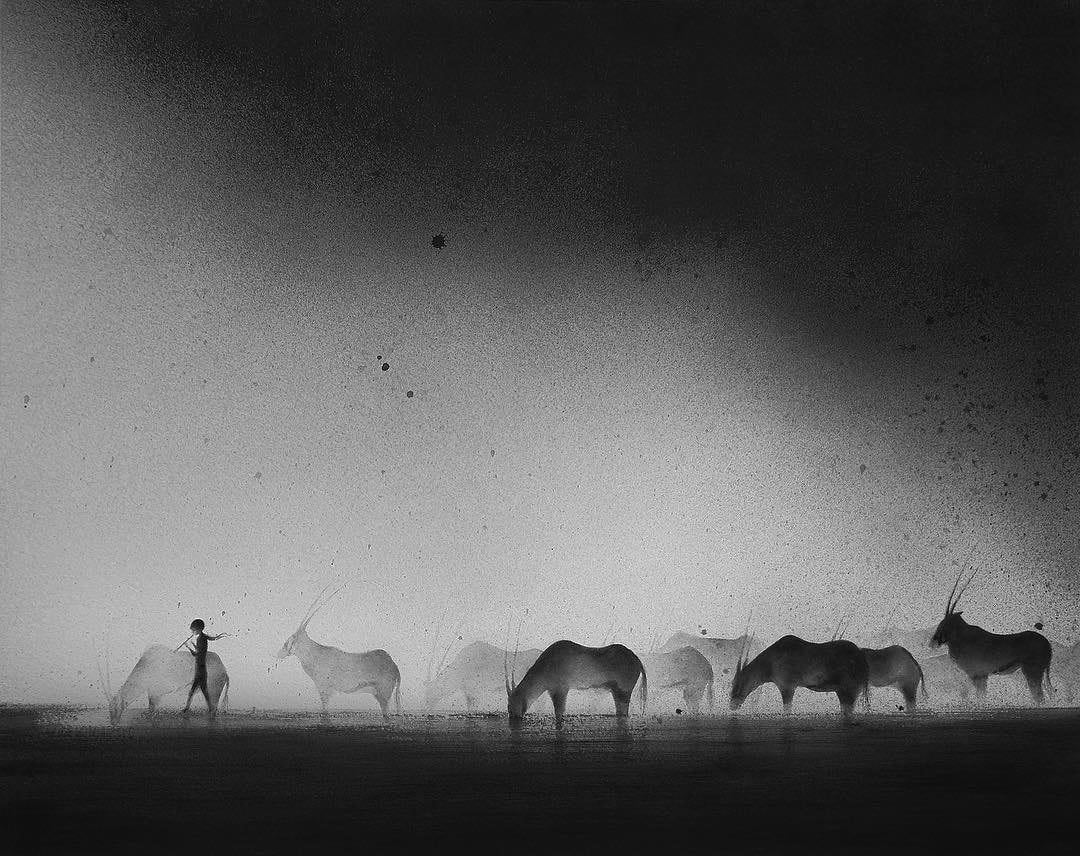
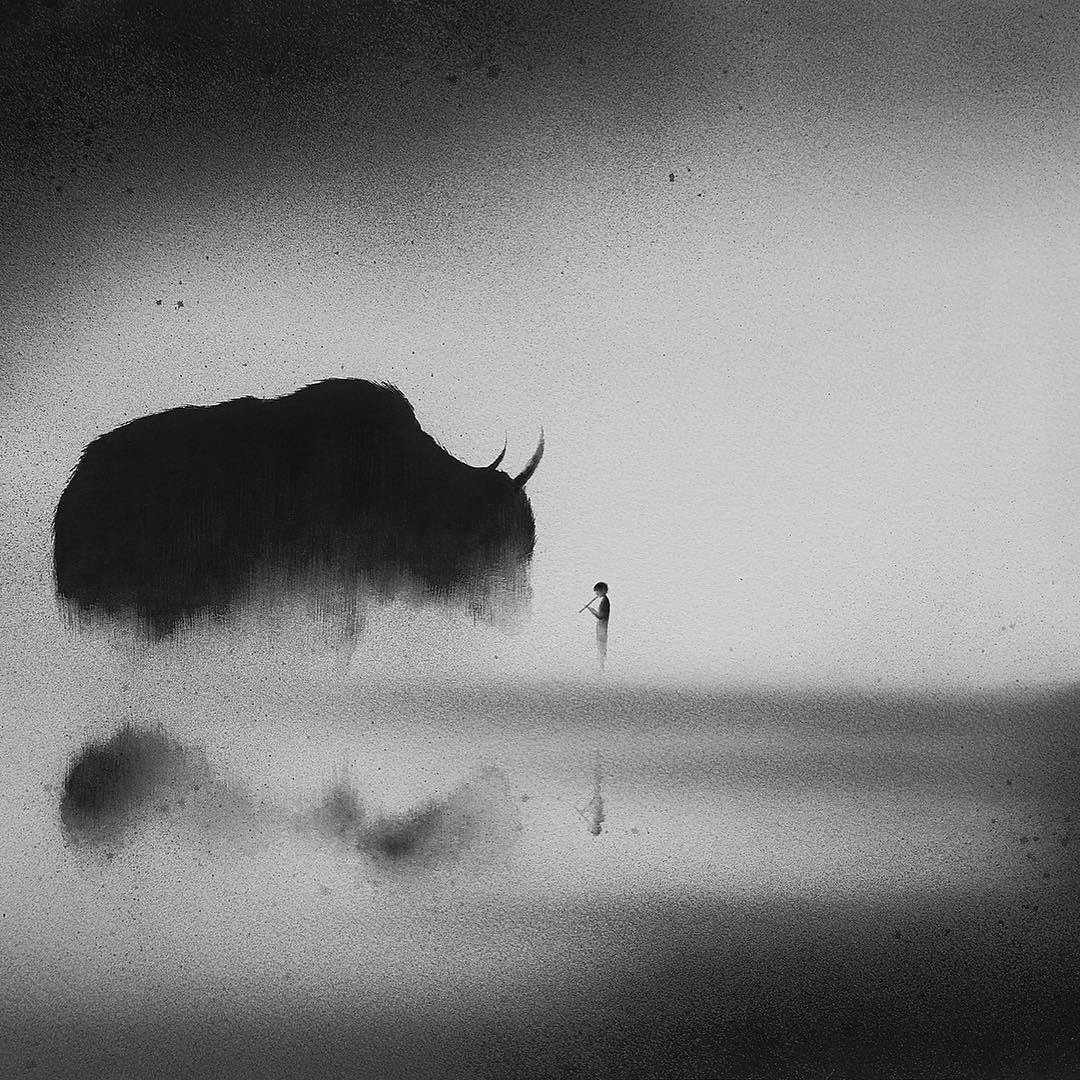
Colossal posted these watercolor paintings by Elicia Edijanto on Friday and I’ve been peeking at them all weekend.
“My subject are often children and animal because they are honest, sincere, unprejudiced and unpretentious,” shares Edijanto. “They give me so much inspiration for [a] particular mood or atmosphere, such as tranquility, solemnity, and also wilderness and freedom, which I put on my paintings.”
Instant follow on Instagram.




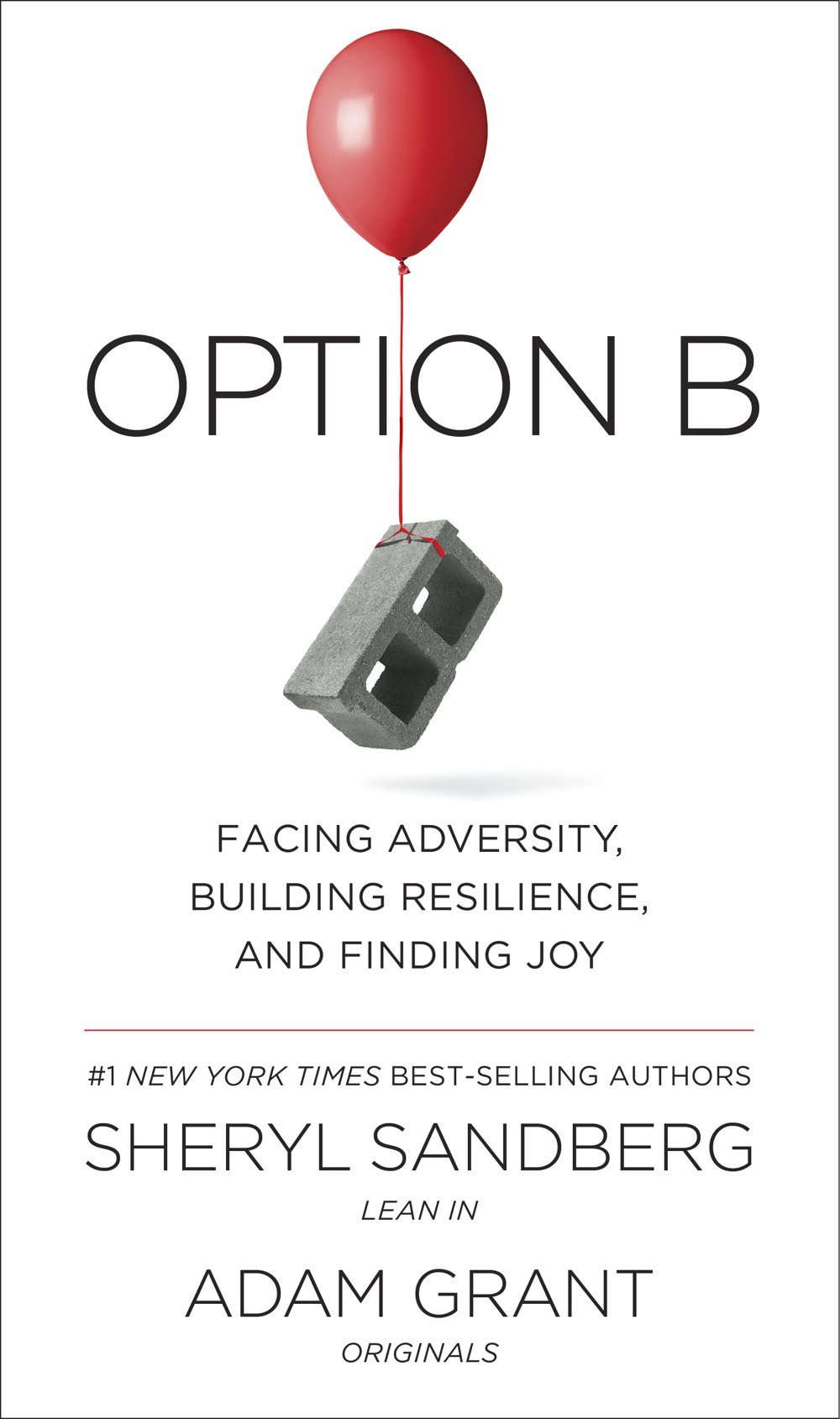
Stay Connected